Lecture 20: Cognitive Behavioral Therapy: Mood Monitors and Thought Records
1/71
There's no tags or description
Looks like no tags are added yet.
Name | Mastery | Learn | Test | Matching | Spaced |
|---|
No study sessions yet.
72 Terms
What did Aaron Beck develop in the early 1960s? (What is Cognitive Behavior Therapy?)
Cognitive therapy, which is now widely known as Cognitive Behavior Therapy (CBT).
What is cognitive therapy now used synonymously with in the field of psychology? (What is Cognitive Behavior Therapy?)
Cognitive Behavior Therapy (CBT).
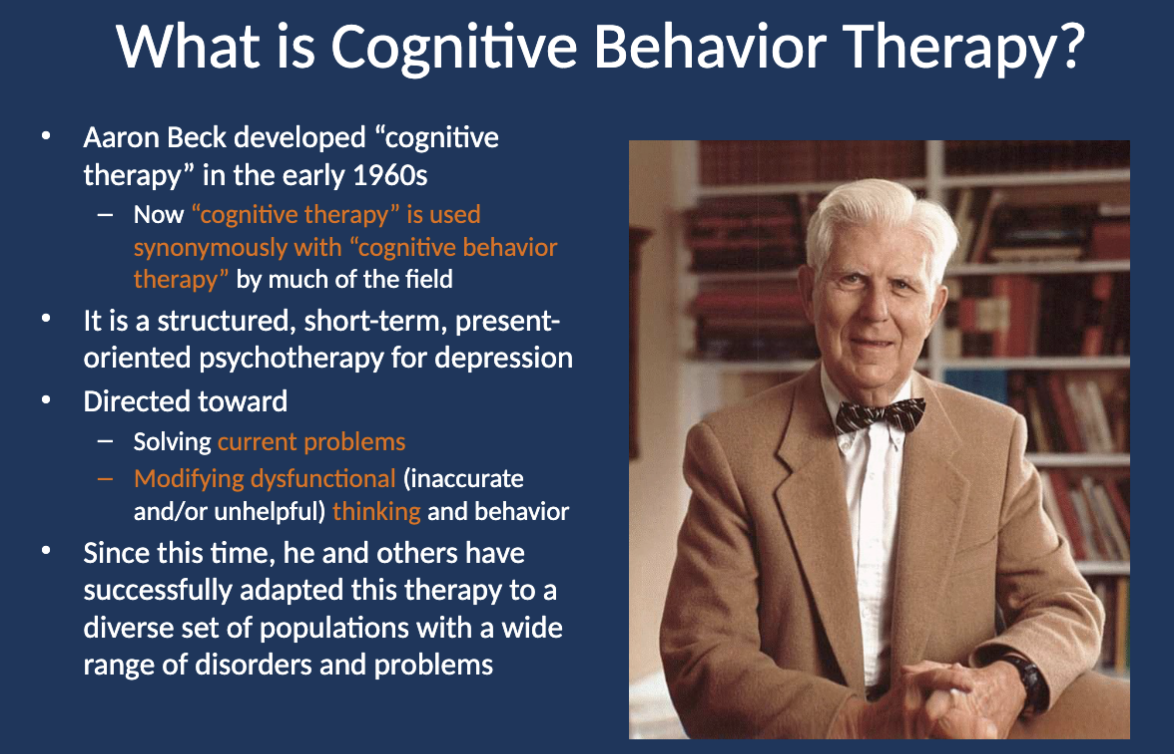
What is cognitive therapy for depression? (What is Cognitive Behavior Therapy?)
A structured, short-term, present-oriented psychotherapy aimed at treating depression.
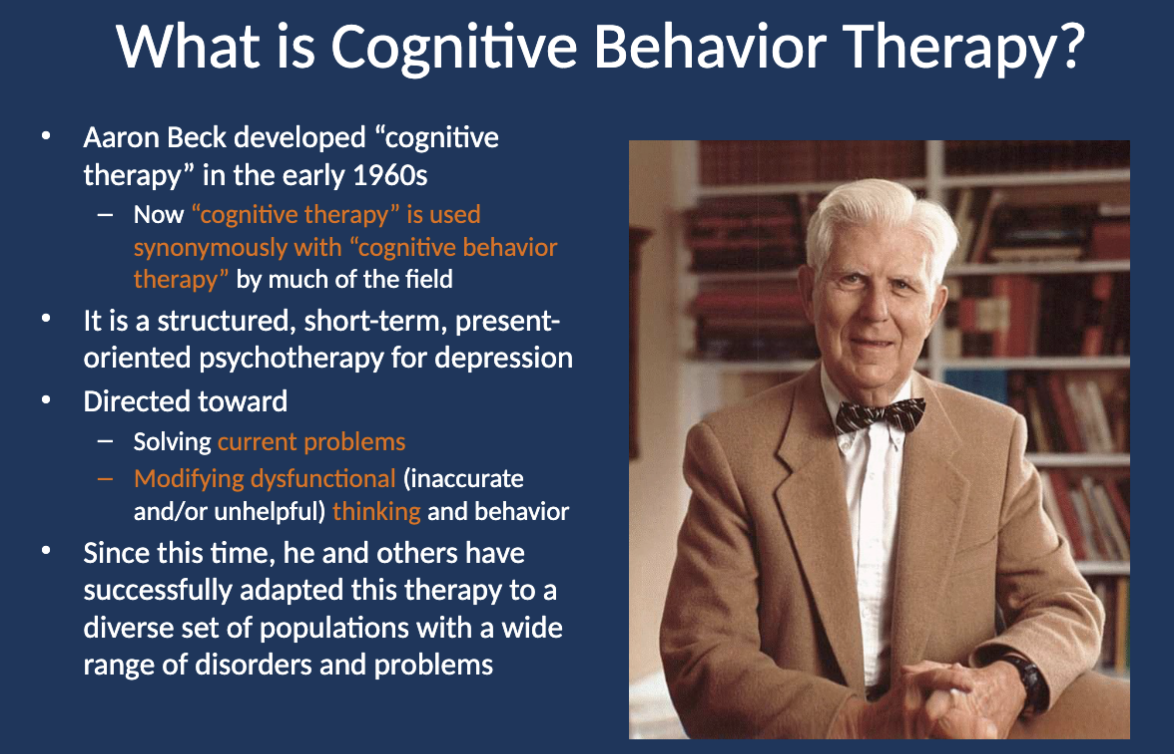
What is CBT directed toward? (What is Cognitive Behavior Therapy?)
Solving current problems and modifying dysfunctional (inaccurate or unhelpful) thinking and behavior.

What are all forms of CBT based on, according to Beck’s model? (What is Cognitive Behavior Therapy?)
A cognitive formulation, beliefs and behavioral strategies of a specific disorder, and a personalized conceptualization of the patient.

What are the forms of CBT derived from Beck’s model? (What is Cognitive Behavior Therapy?)
Rational Emotive Behavior Therapy (Ellis)
Dialectical Behavior Therapy (Linehan)
Problem-Solving Therapy (D’Zurilla & Nezu)
Acceptance and Commitment Therapy (Resick & Schnicke)
Exposure Therapy (Foa & Rothbaum)
Cognitive Processing Therapy (Resick & Schnicke)
Cognitive Behavioral Analysis System of Psychotherapy (McCullough)
Cognitive Behavior Modification (Meichenbaum)
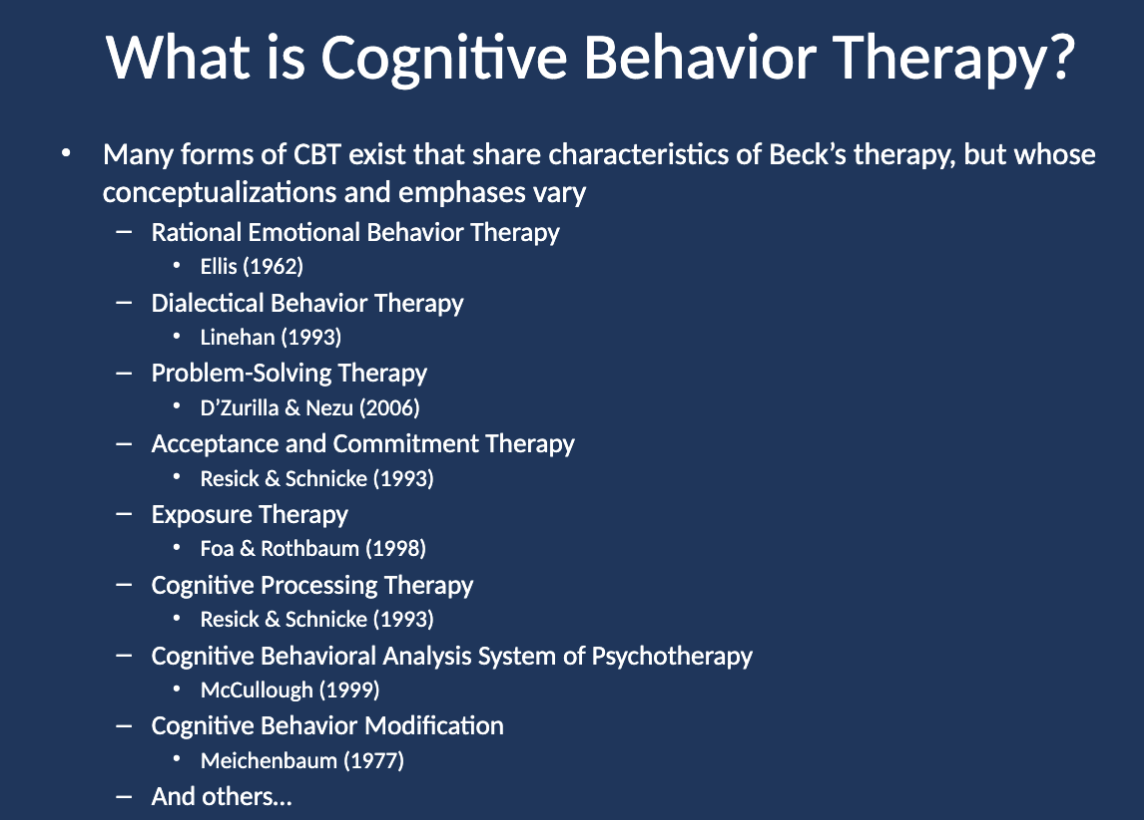
How has CBT been adapted? (What is Cognitive Behavior Therapy?)
For patients of diverse income levels, cultural backgrounds, and ages—from young children to older adults.

In what settings is CBT used? (What is Cognitive Behavior Therapy?)
Primary care, medical offices, schools, vocational programs, prisons, and more.
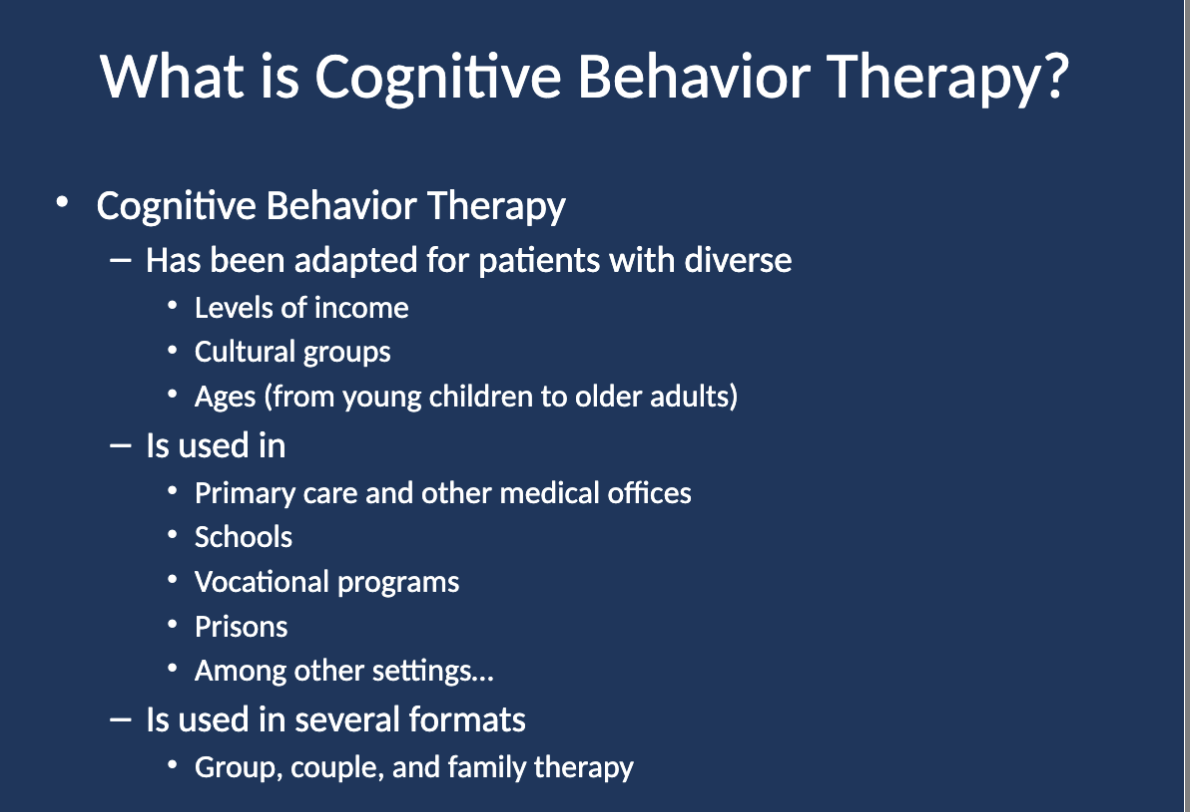
In what formats is CBT offered? (What is Cognitive Behavior Therapy?)
Group therapy, couple therapy, and family therapy.
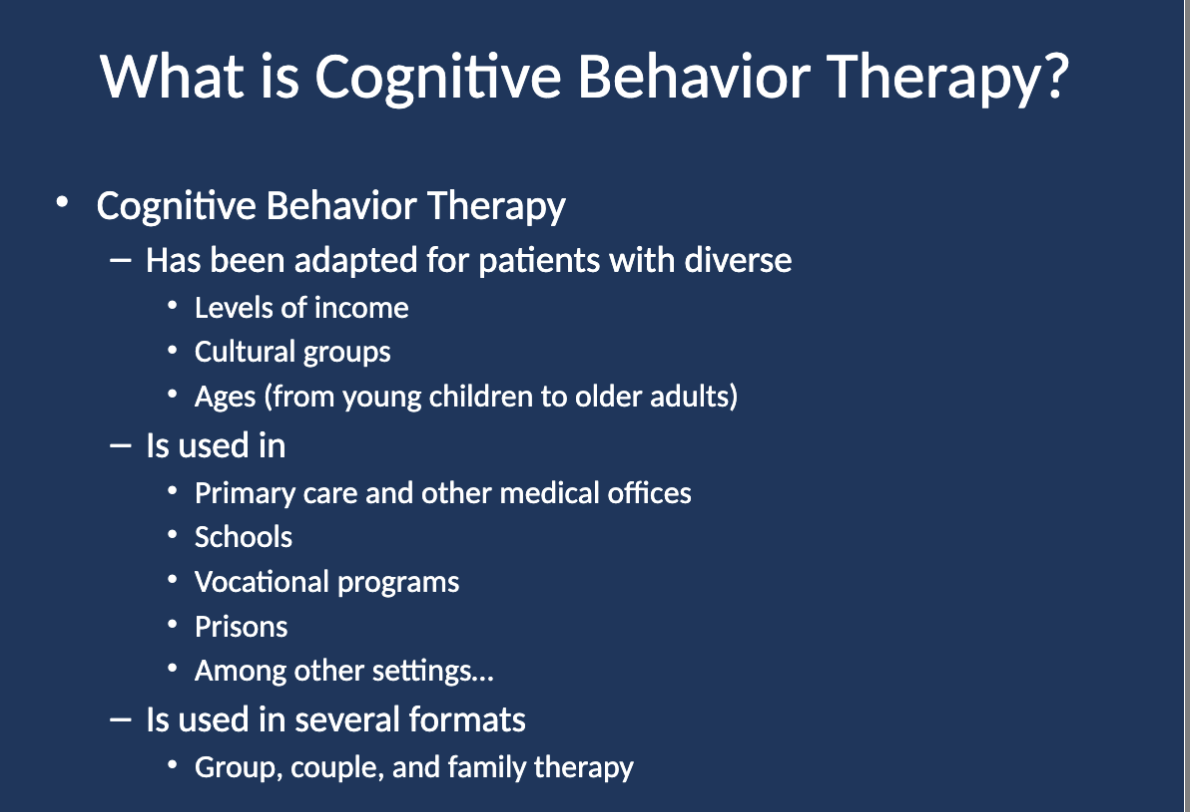
What does the cognitive model propose? (Cognitive Theory)
That dysfunctional thinking, which influences mood and behavior, is common to all psychological disturbances.

What happens when people learn to evaluate their thinking more realistically and adaptively? (Cognitive Theory)
They experience improvements in their emotional state and behavior.
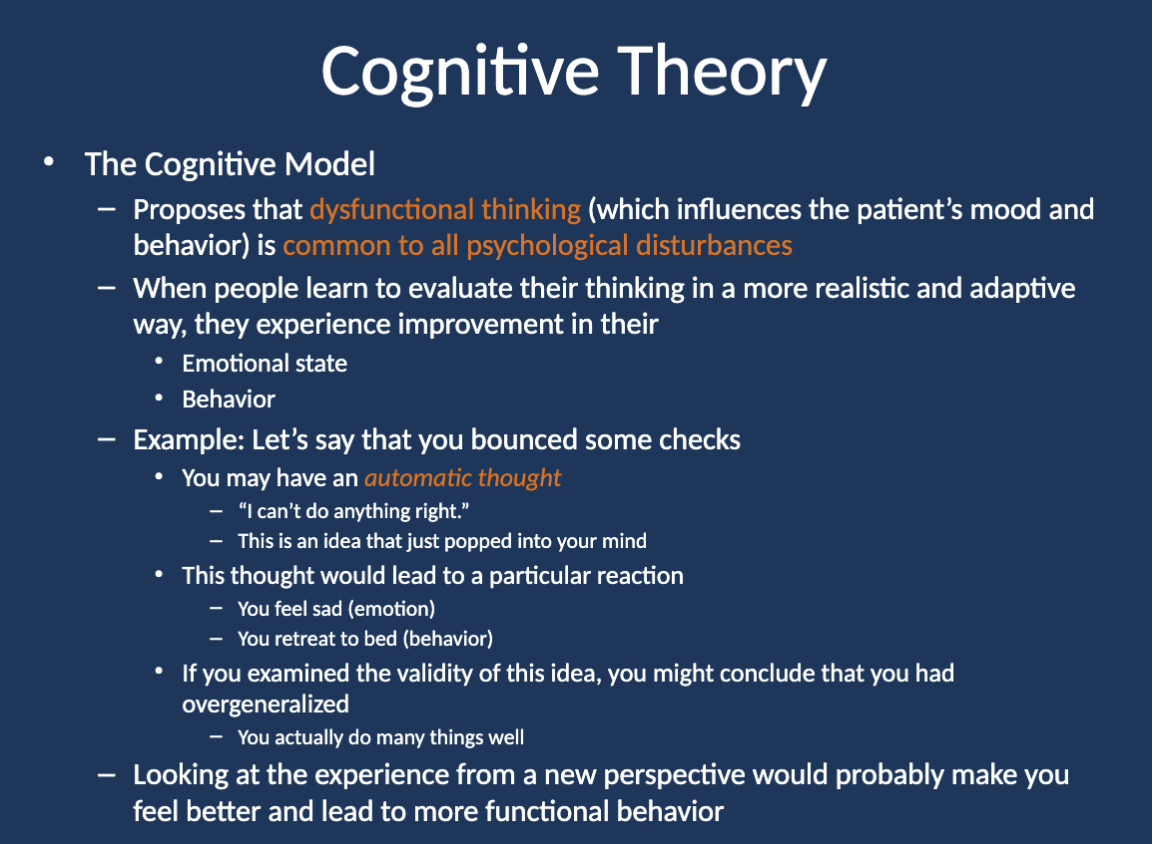
What is an example of an automatic thought leading to emotional and behavioral reactions? (Cognitive Theory)
After bouncing checks, you might automatically think, "I can't do anything right," leading to sadness and withdrawing to bed.
What does examining the validity of an automatic thought do? (Cognitive Theory)
It helps you realize if you're overgeneralizing, which can change your perspective and improve your mood and actions.

What must patients do for lasting improvement in mood and behavior? (Cognitive Theory)
Work on modifying their deeper, underlying dysfunctional beliefs.
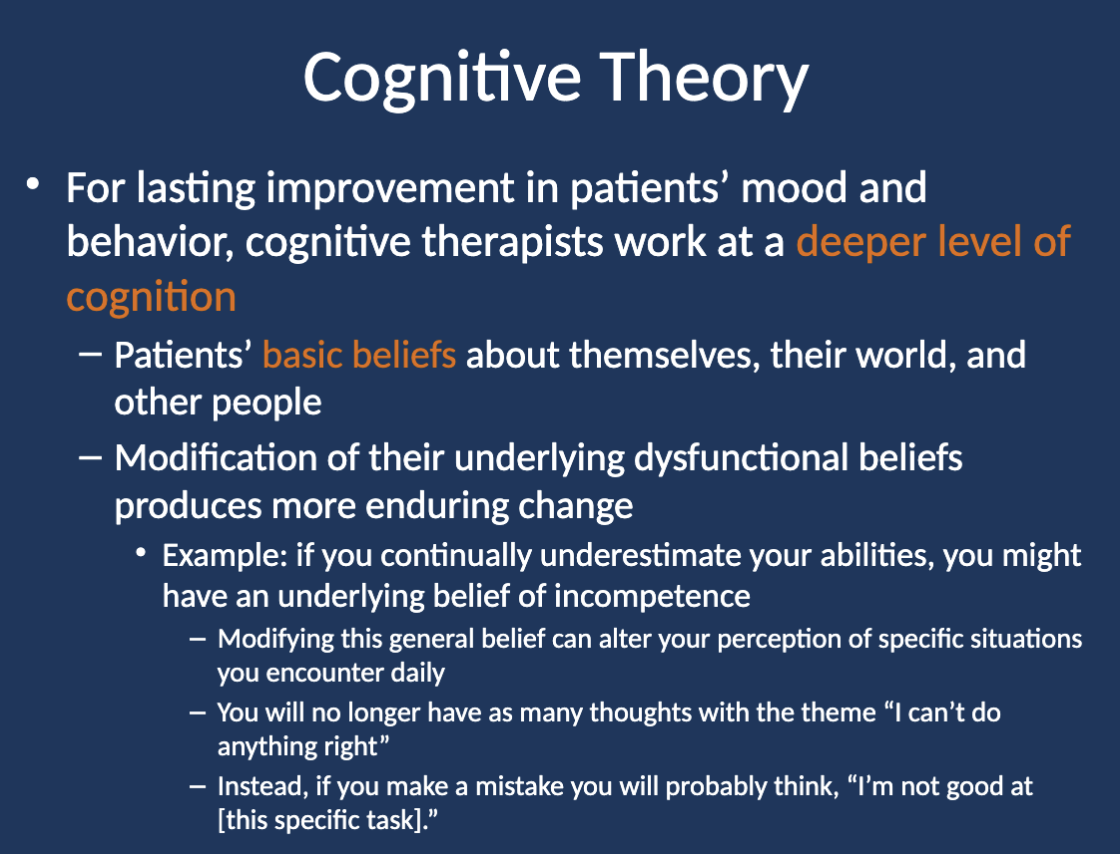
What does this deeper level of work in cognitive therapy involve? (Cognitive Theory)
Changing basic beliefs about the self, the world, and others to produce more enduring change.
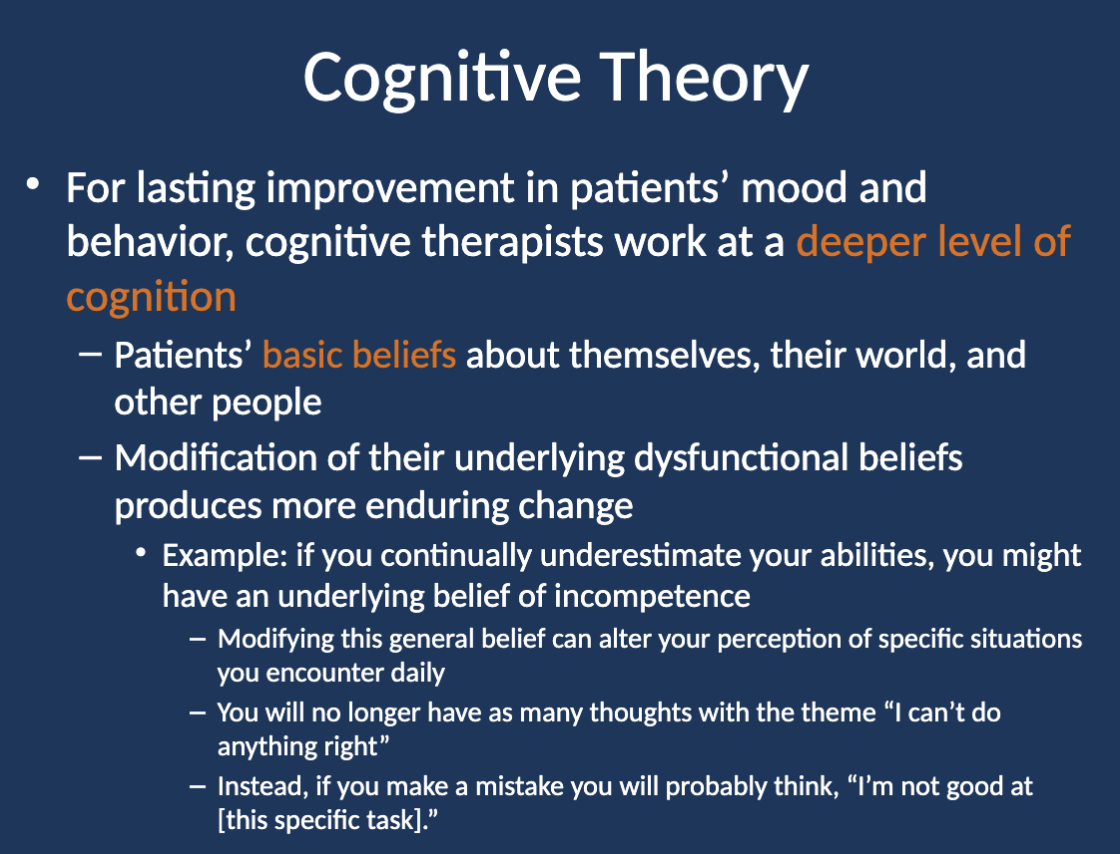
What is an example of modifying a basic belief? (Cognitive Theory)
If you often think you're incompetent, modifying that belief can help you respond to mistakes with thoughts like, "I’m not good at this specific task," rather than broad self-criticism.
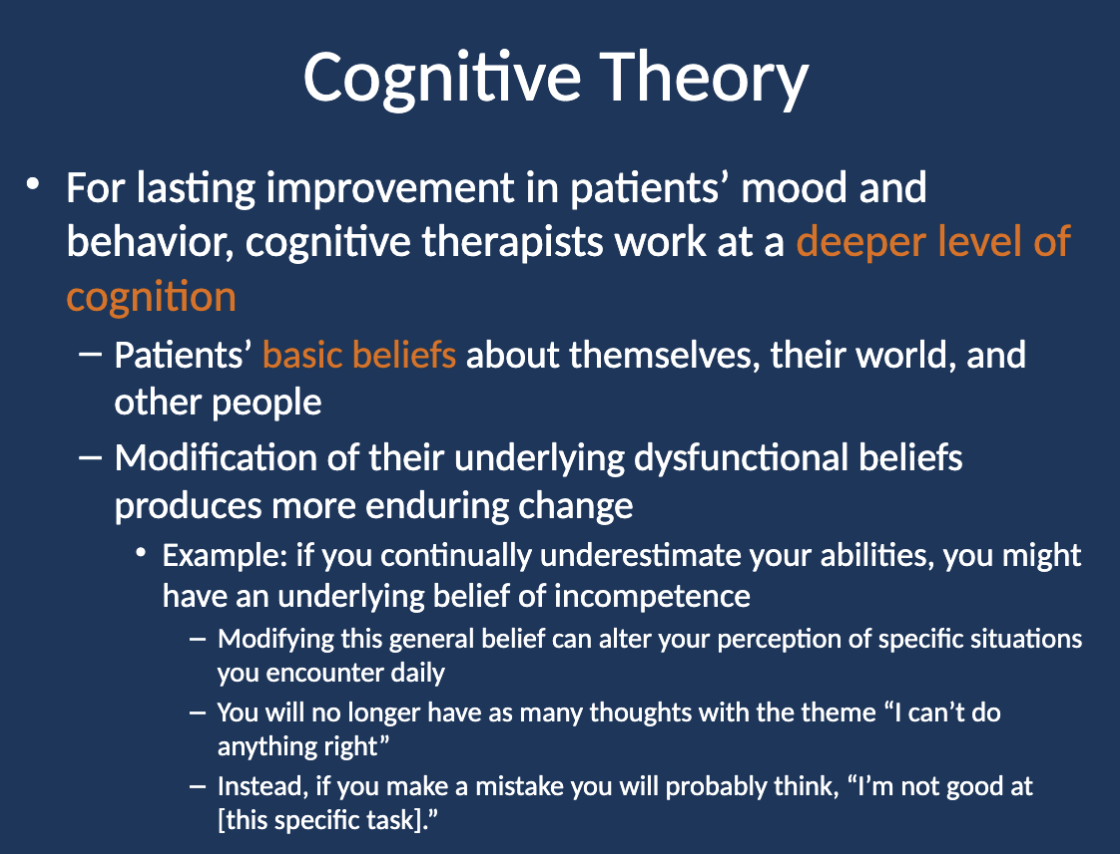
When was the first outcome study on CBT published? (What Does the Research Say?)
In 1977 by Rush et al.
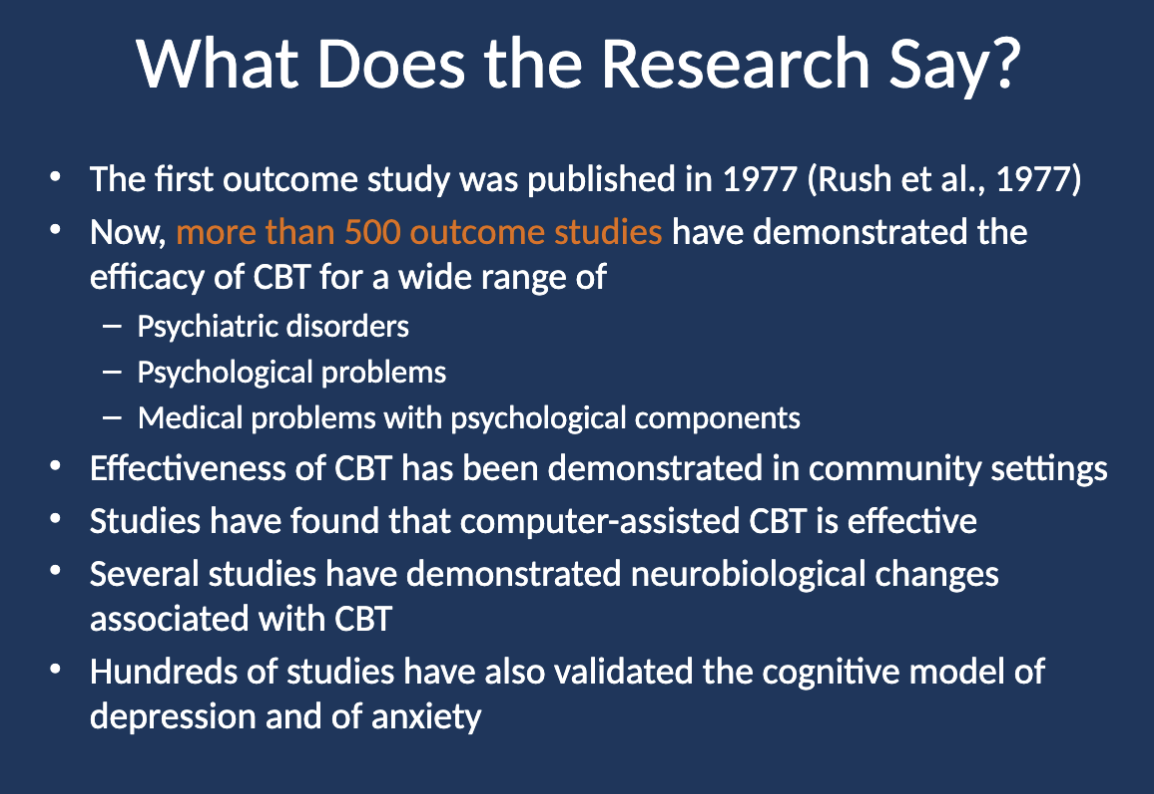
How many outcome studies on CBT have been conducted and what do they show? (What Does the Research Say?)
Over 500 studies have been done, showing CBT’s efficacy for psychiatric, psychological, and medical problems with psychological components.
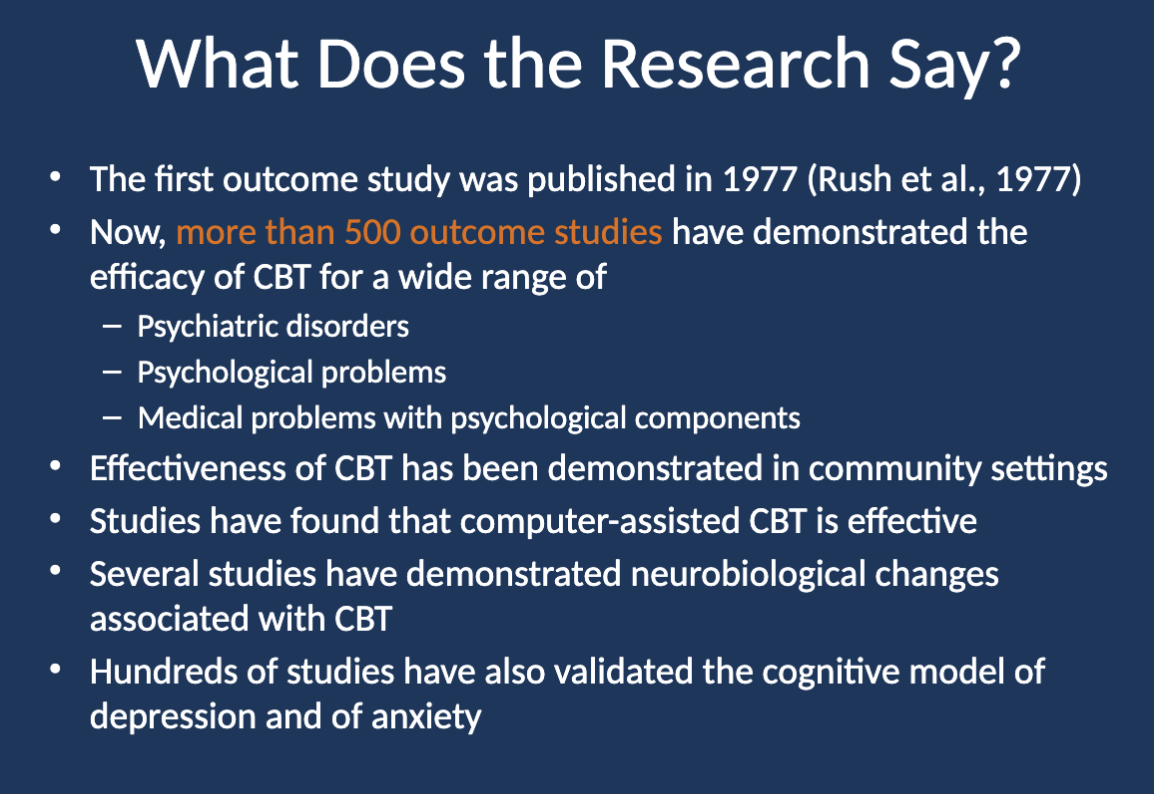
What is "efficacy" in the context of CBT research? (What Does the Research Say?)
Efficacy refers to how well CBT works under controlled, clinical research conditions.
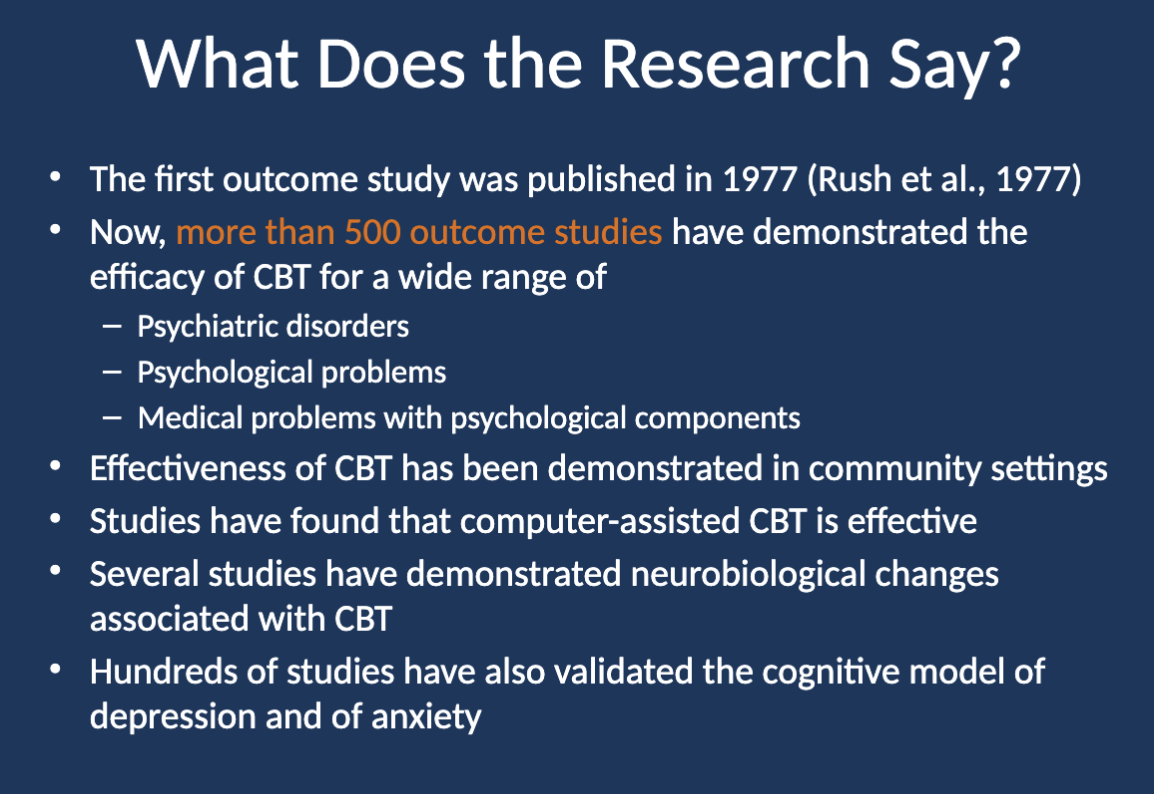
What have studies demonstrated and validated about CBT? (What Does the Research Say?)
Studies have demonstrated its effectiveness in community settings, the effectiveness of computer-assisted CBT, neurobiological changes from CBT, and validated the cognitive model of depression and anxiety.
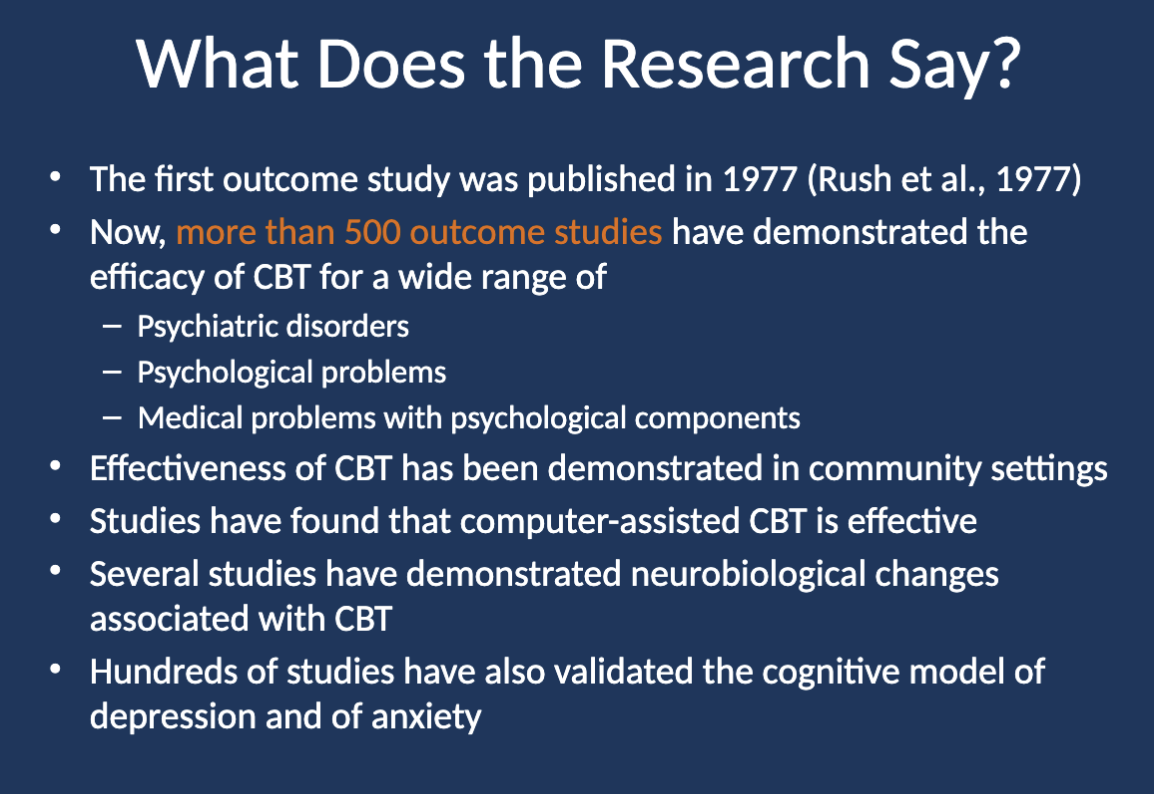
What are some psychiatric disorders successfully treated with CBT? (Partial List of Disorders Successfully Treated By CBT)
Depression, anxiety disorders, PTSD, OCD, bipolar disorder, schizophrenia (as an adjunct), and eating disorders.

What are some psychological problems CBT has been effective in treating? (Partial List of Disorders Successfully Treated By CBT)
Low self-esteem, anger management, stress, sleep disturbances, and interpersonal difficulties.
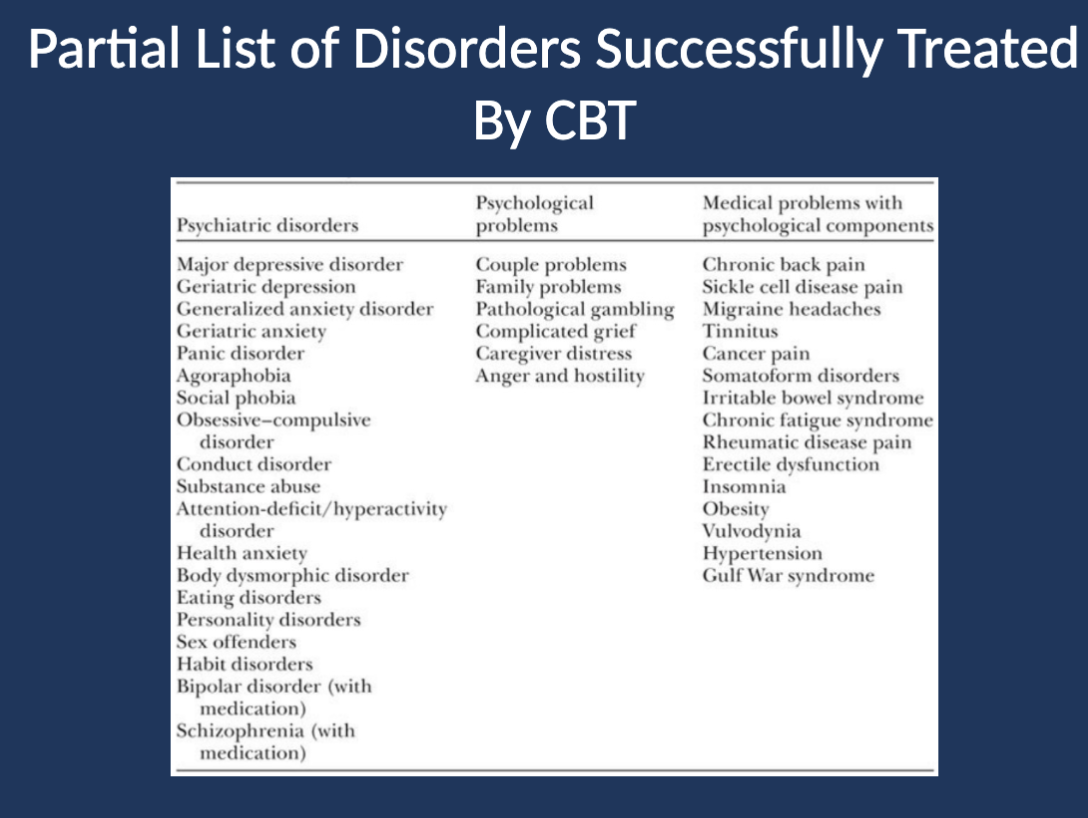
What are some medical problems with psychological components that CBT has successfully treated? (Partial List of Disorders Successfully Treated By CBT)
Chronic pain, irritable bowel syndrome (IBS), insomnia, hypertension, and diabetes management.
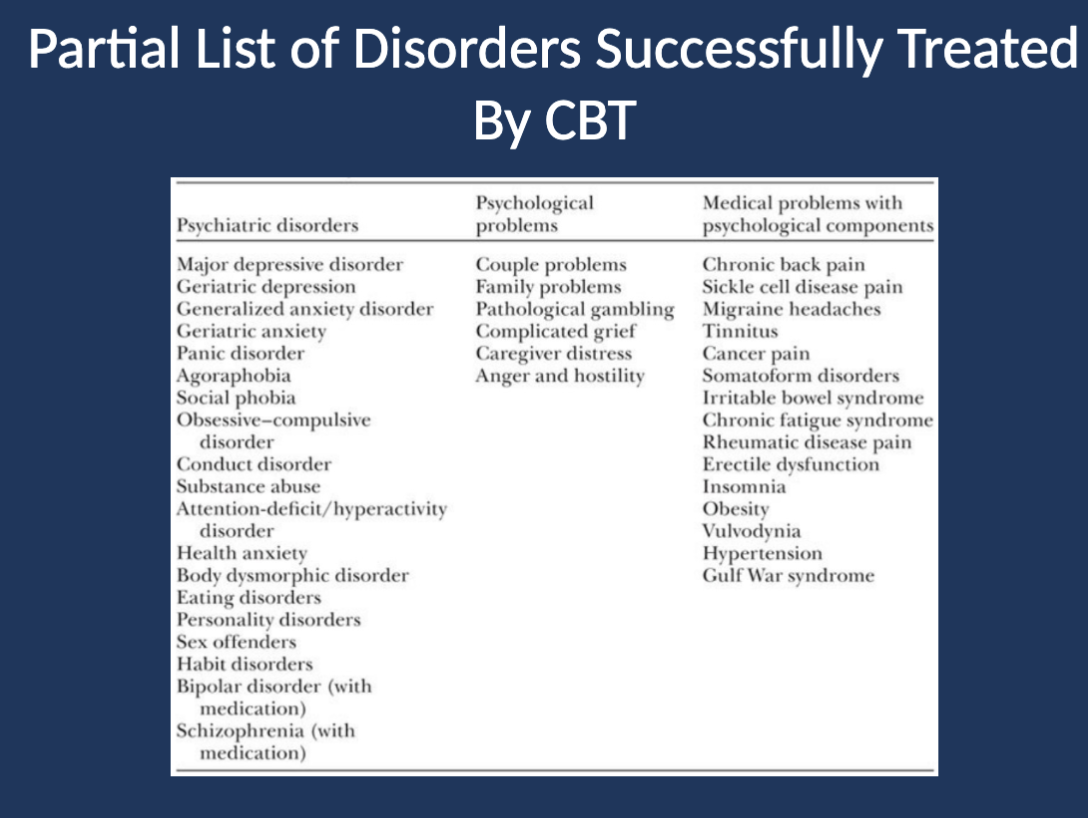
What are the basic principles of CBT? (Basic Principles of Treatment)
They are foundational guidelines that structure cognitive behavior therapy, emphasizing individualized treatment, goal orientation, patient education, and structured sessions.
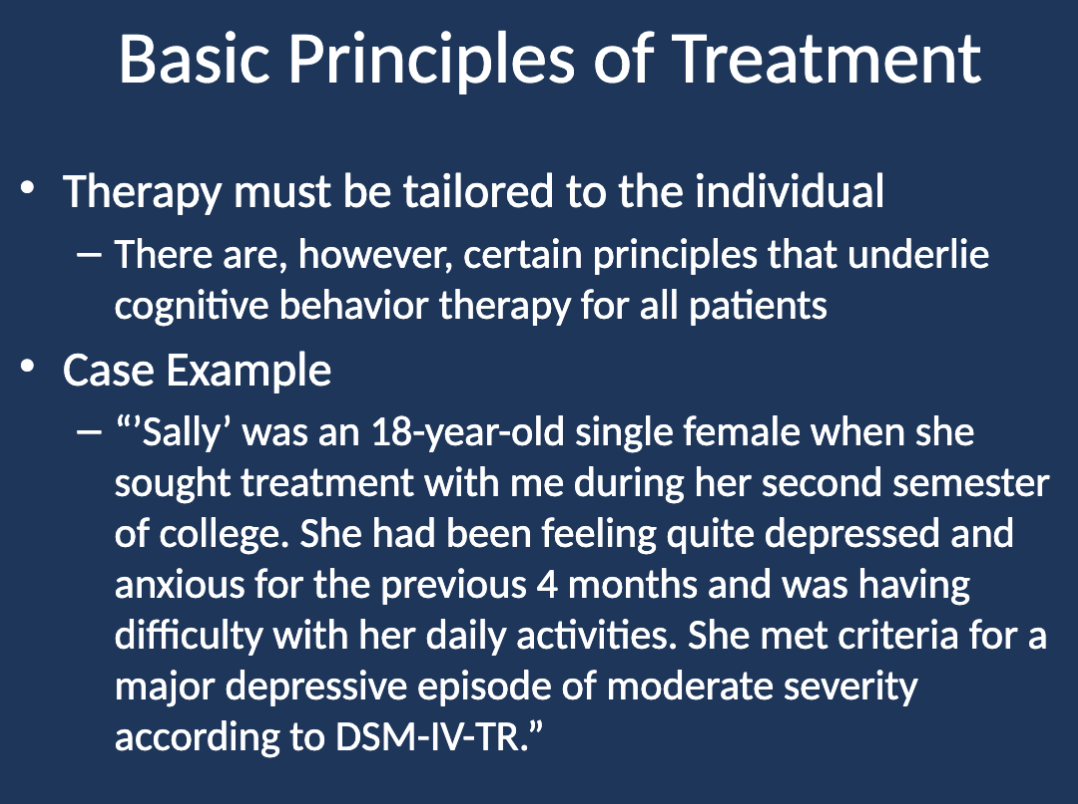
What are the 10 basic principles of CBT? (Basic Principles of Treatment)
Based on an individualized formulation in cognitive terms
Requires a strong therapeutic alliance
Emphasizes collaboration and active participation
Goal-oriented and problem-focused
Focuses initially on the present
Educative, teaching patients to be their own therapists
Aims to be time-limited
Uses structured sessions
Teaches patients to identify, evaluate, and respond to dysfunctional thoughts
Uses a variety of techniques to change thinking, mood, and behavior

What does Sally’s case illustrate in CBT? (Basic Principles of Treatment)
Sally's depressive thoughts (e.g., "I'm a failure") contribute to sadness and isolation.
Her behaviors (withdrawing, not asking for help) reinforce dysfunctional thinking.
Her depression was influenced by stressors (e.g., leaving home, academic struggles).
Developmentally, she attributes successes to luck and failures to her "true" self, shaping her beliefs of incompetence.
Therapy involves addressing these thoughts, setting goals, and restructuring beliefs.

What is Principle No. 1 of CBT? (Basic Principles of Treatment: Principle 1)
CBT is based on an ever-evolving formulation of patients’ problems and an individualized conceptualization of each patient in cognitive terms.
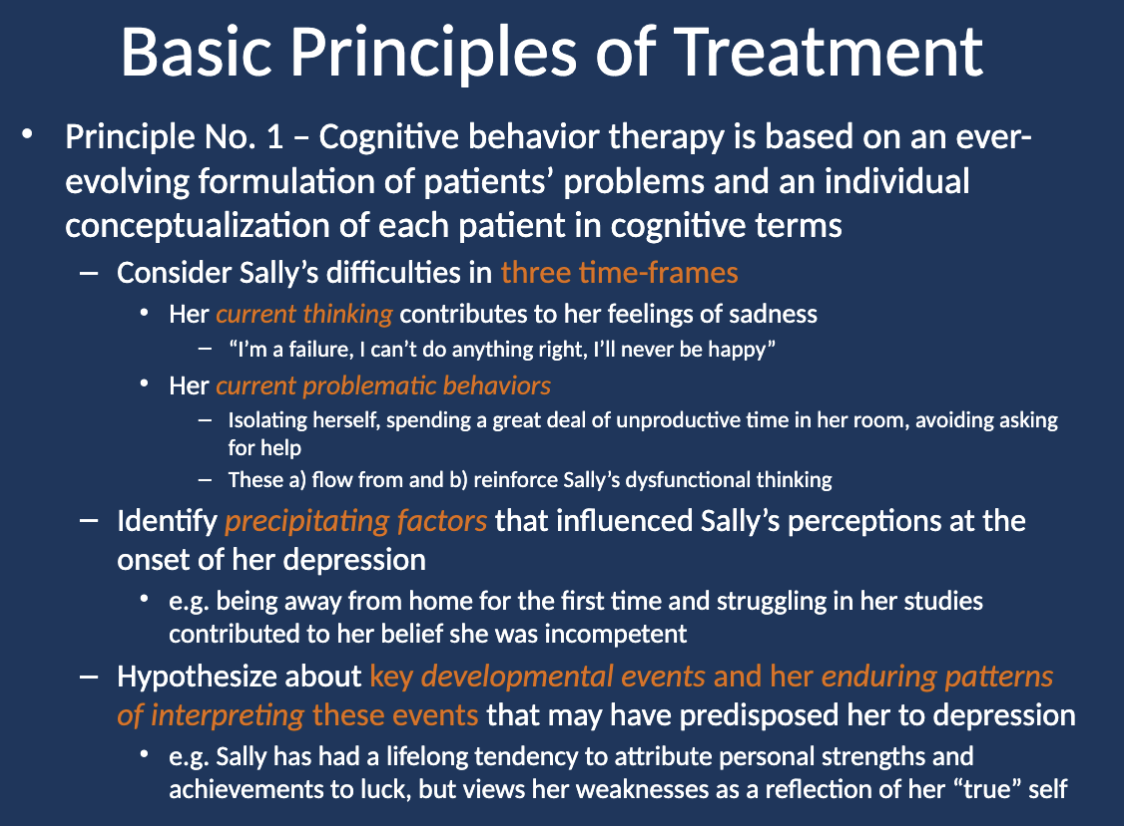
What are the three time-frames considered in Sally’s case? (Basic Principles of Treatment: Principle 1)
Current thinking
Current problematic behaviors
Past experiences that may have predisposed her to depression
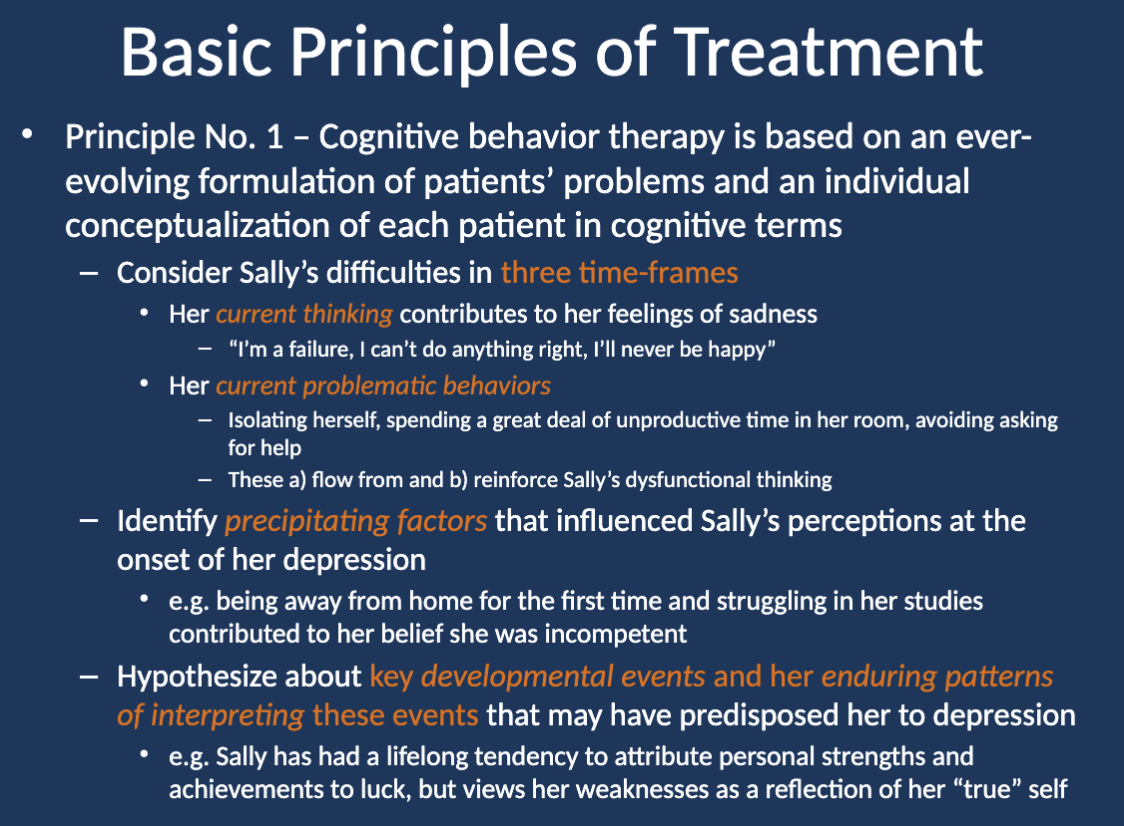
What is Sally’s current thinking that contributes to her sadness? (Basic Principles of Treatment: Principle 1)
Thoughts like “I’m a failure, I can’t do anything right, I’ll never be happy.”
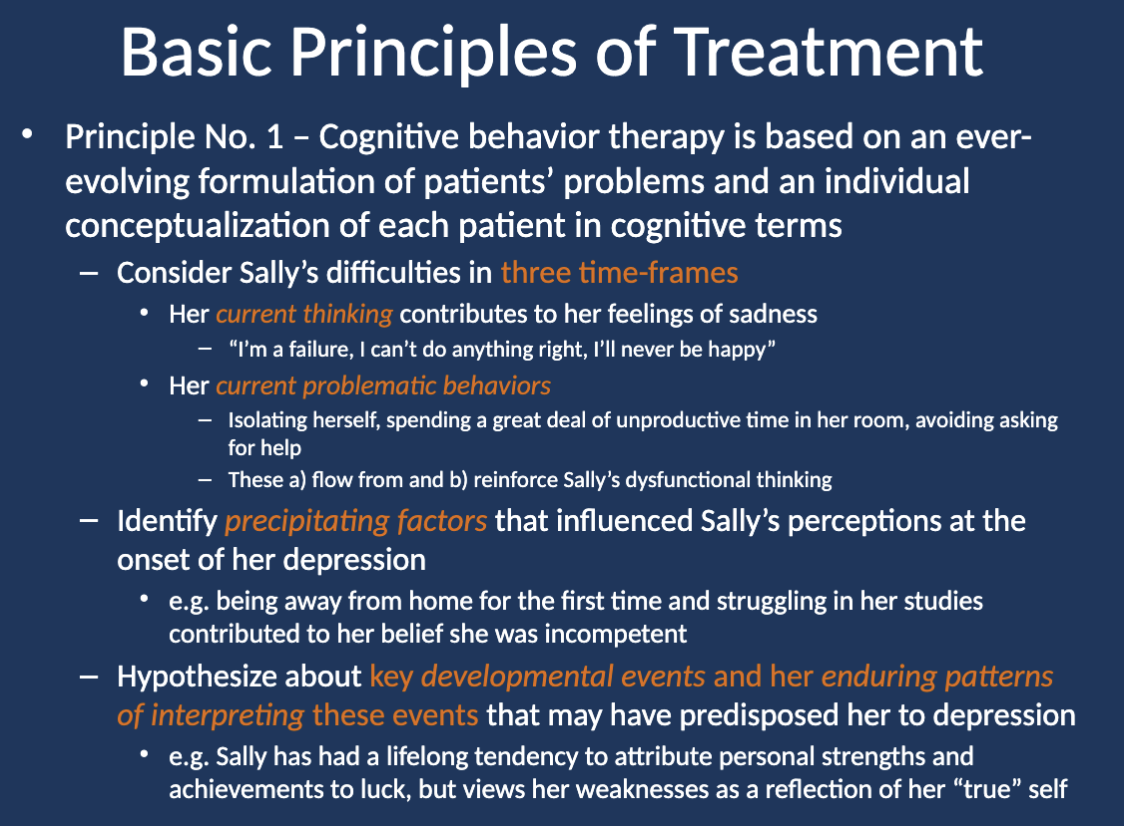
What are Sally’s current problematic behaviors? (Basic Principles of Treatment: Principle 1)
Isolating herself, spending unproductive time in her room, and avoiding asking for help.
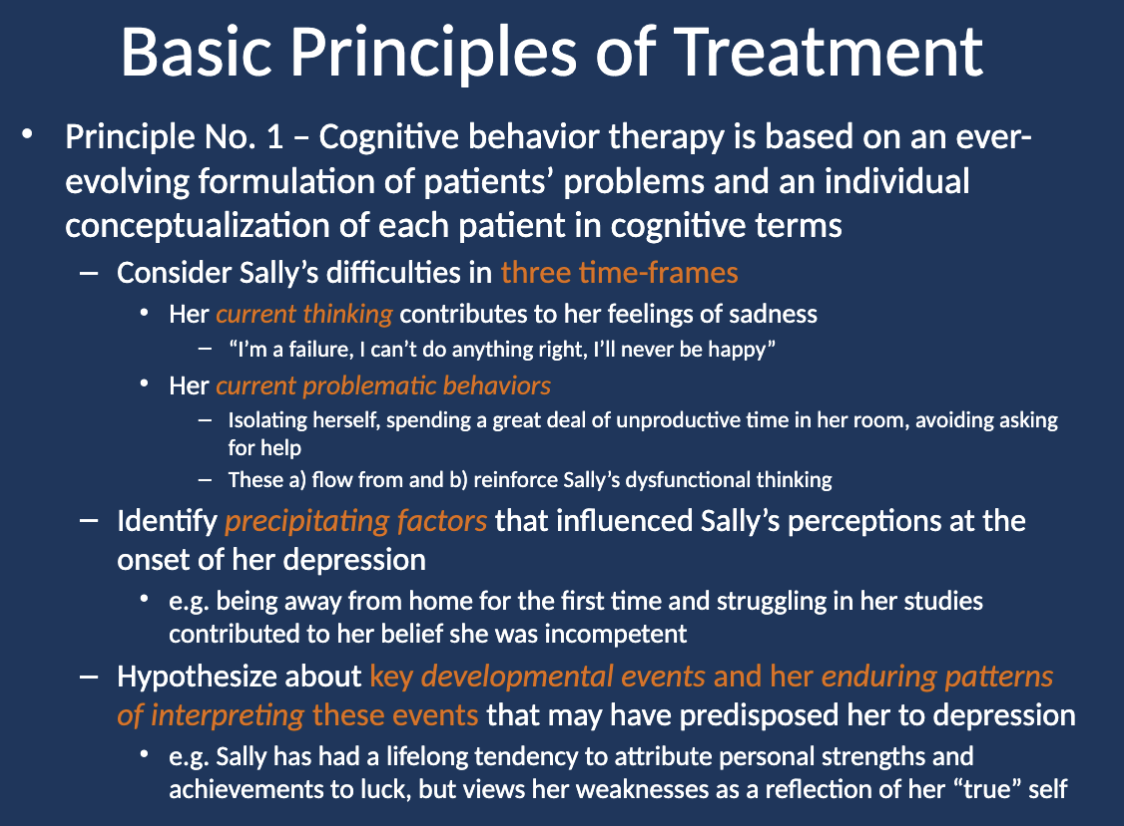
What are precipitating factors in Sally’s case? (Basic Principles of Treatment: Principle 1)
Events like being away from home for the first time and academic struggles that led her to believe she was incompetent.
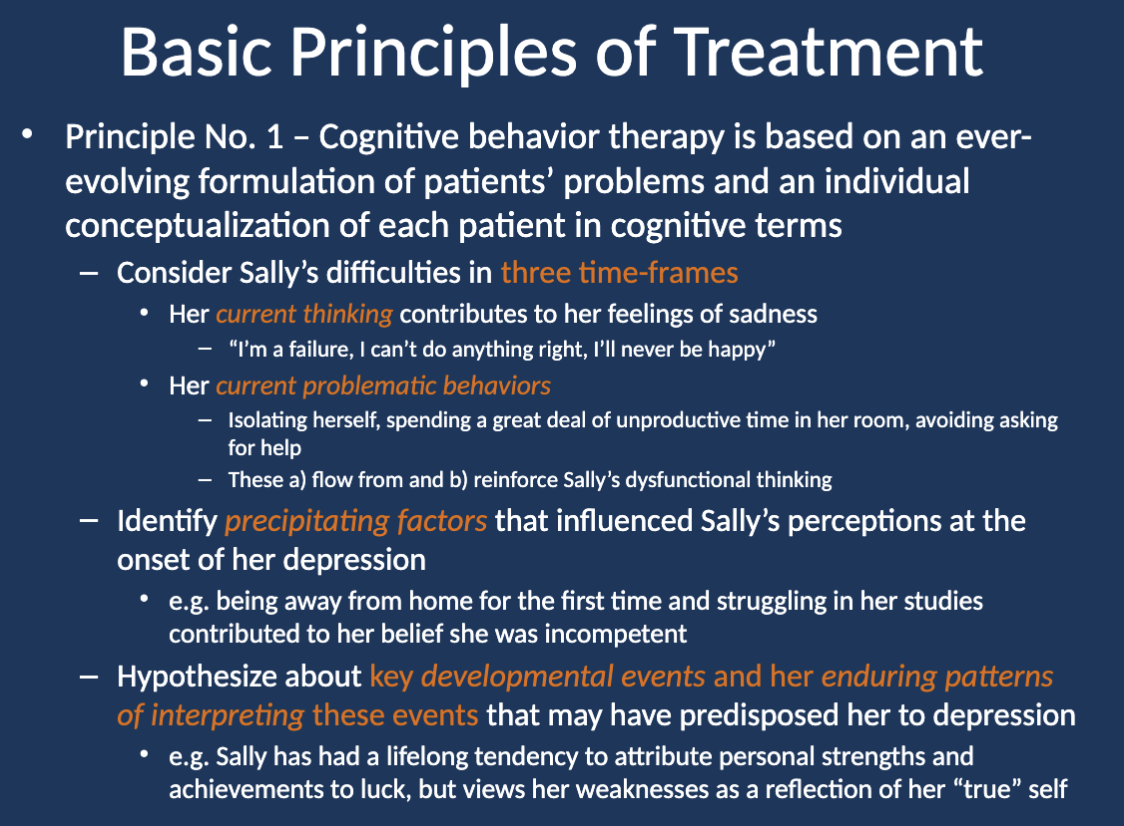
What do therapists hypothesize about in Sally’s developmental history? (Basic Principles of Treatment: Principle 1)
Key developmental events and enduring patterns of interpreting these events, like her tendency to attribute strengths to luck and view weaknesses as part of her “true” self, which may predispose her to depression.
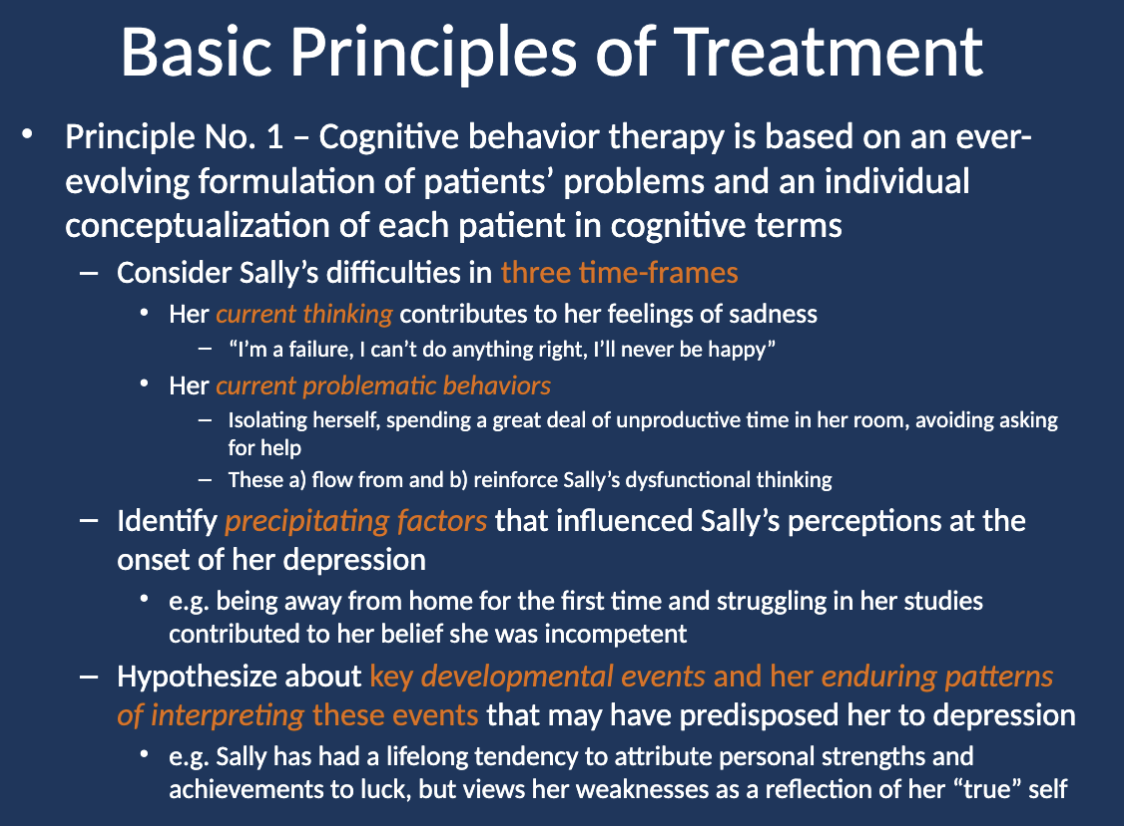
What is Principle No. 2 of CBT? (Basic Principles of Treatment: Principle 2)
CBT requires a sound therapeutic alliance between therapist and patient.
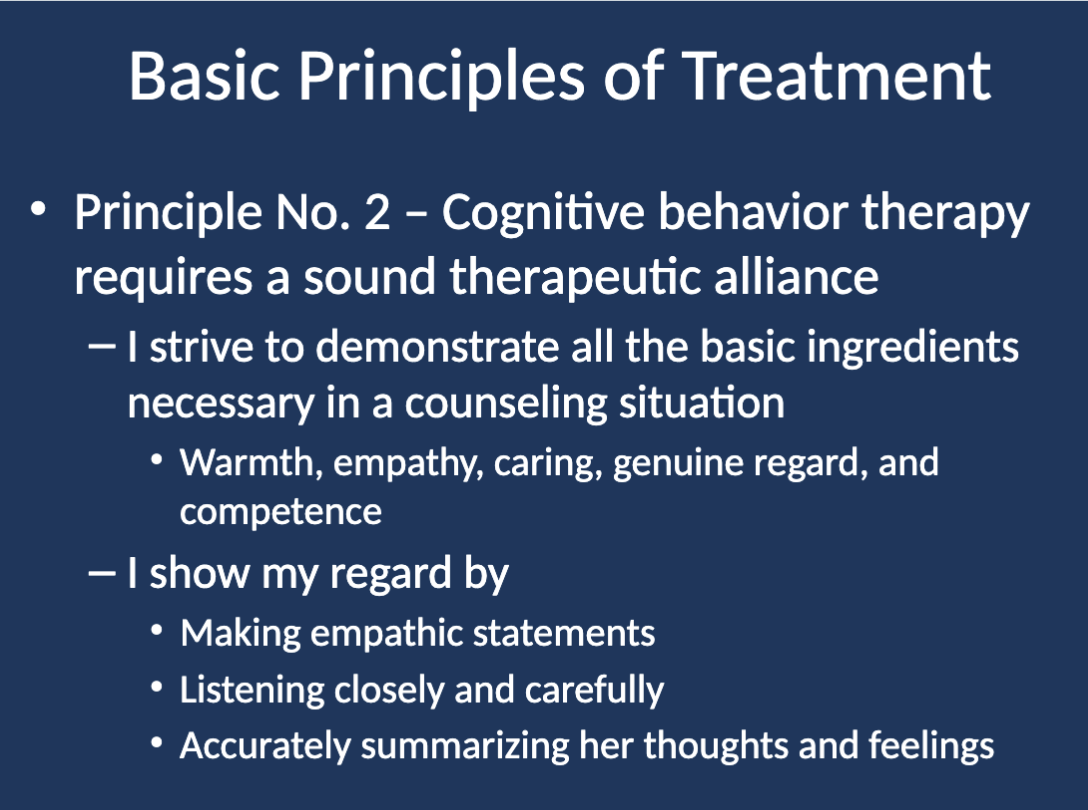
As a therapist, what do I strive to demonstrate in the therapeutic relationship? (Basic Principles of Treatment: Principle 2)
Warmth, empathy, caring, genuine regard, and competence.
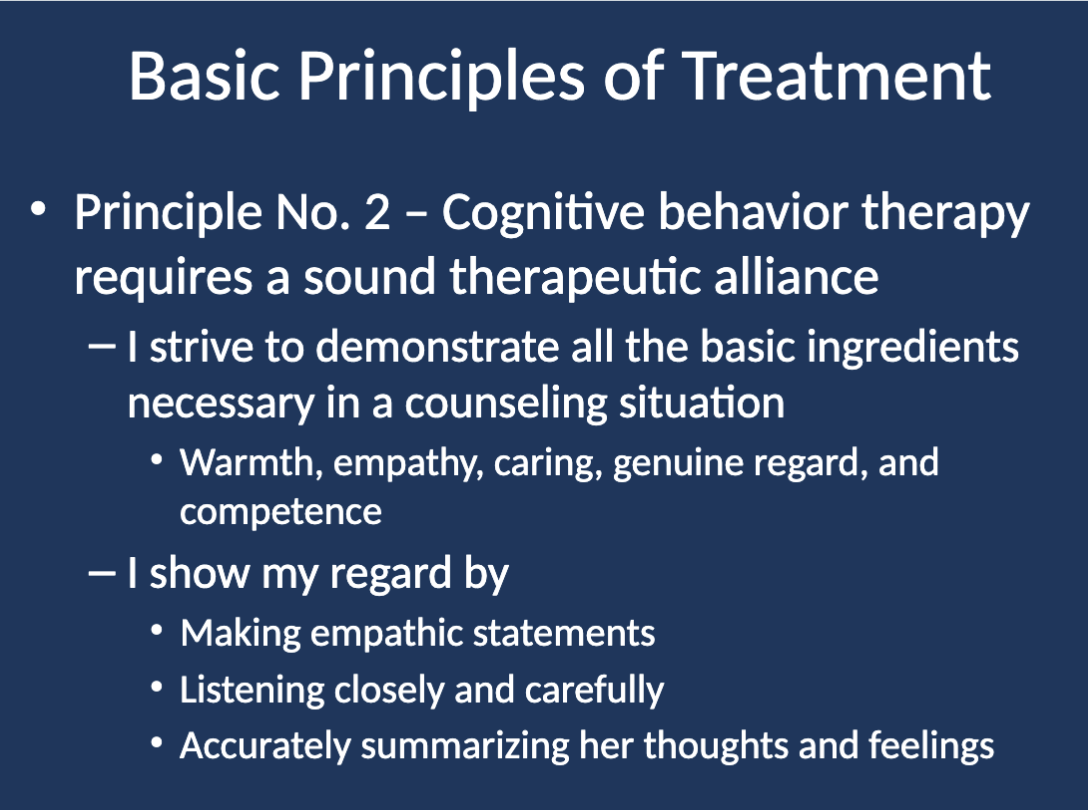
How do I show my regard for the patient as a therapist? (Basic Principles of Treatment: Principle 2)
By making empathic statements, listening closely and carefully, and accurately summarizing the patient’s thoughts and feelings.

What is Principle No. 3 of CBT? (Basic Principles of Treatment: Principle 3)
CBT emphasizes collaboration and active participation between therapist and patient.
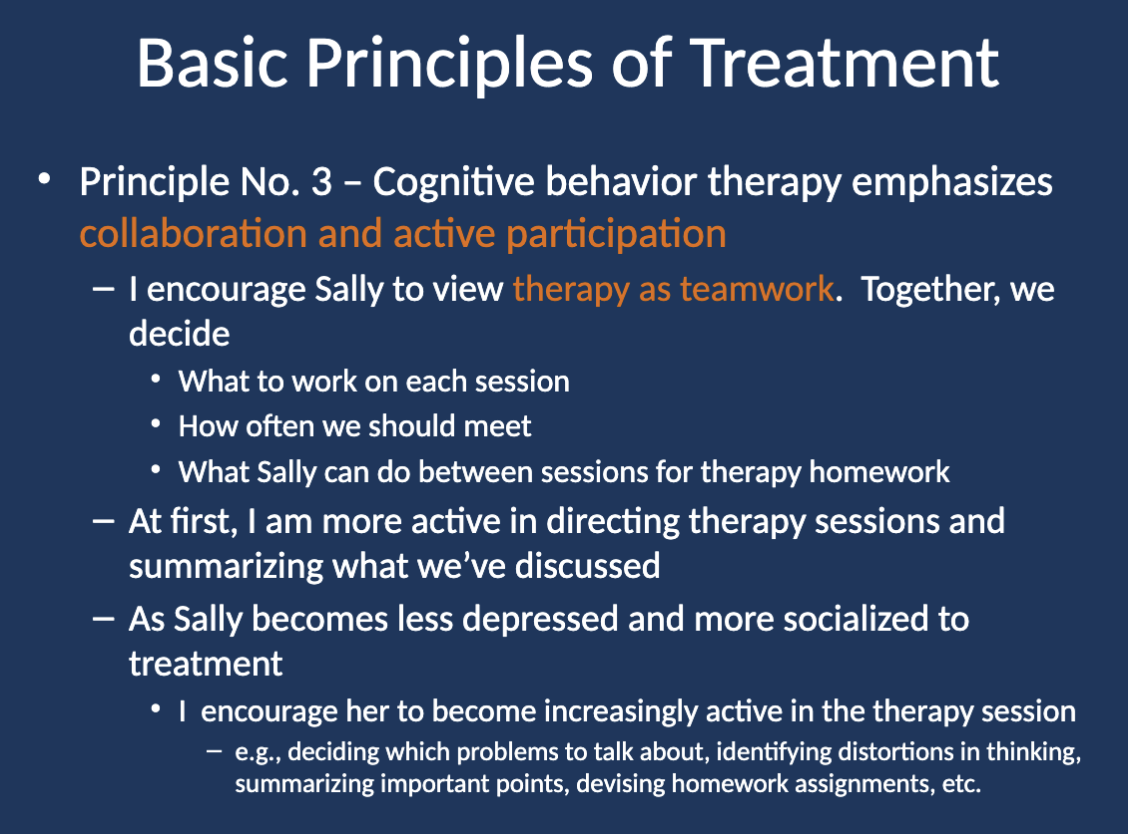
What do I encourage Sally to view therapy as, and what do we decide together? (Basic Principles of Treatment: Principle 3)
I encourage her to view therapy as teamwork. Together, we decide what to work on each session, how often to meet, and what she can do for therapy homework.
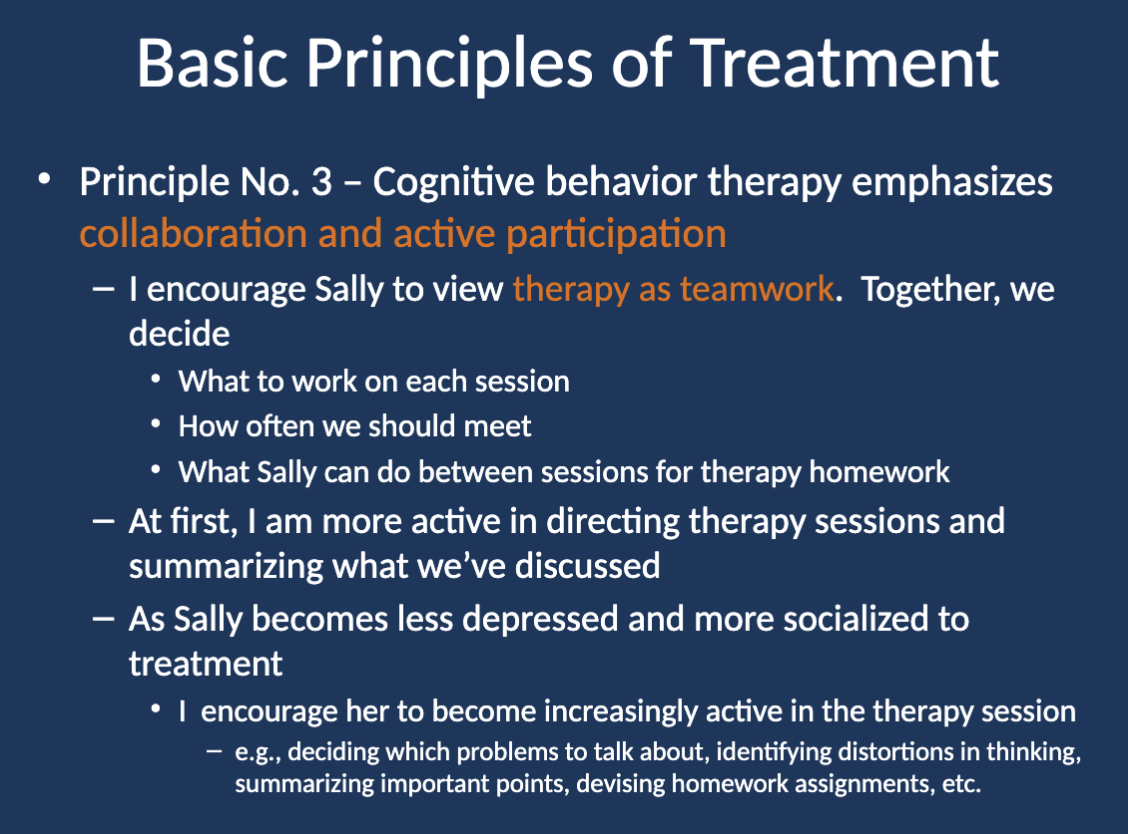
What do I do at first as the therapist? (Basic Principles of Treatment: Principle 3)
I take a more active role in directing therapy sessions and summarizing what we’ve discussed.
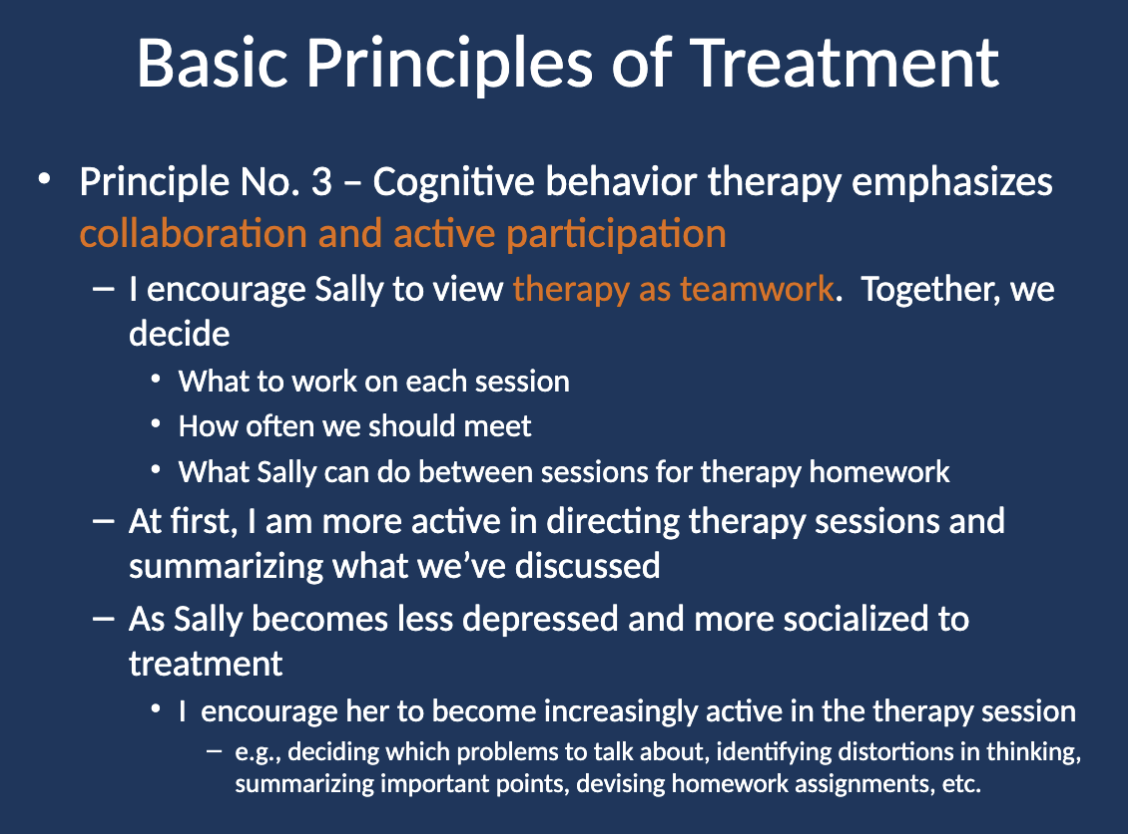
What happens as Sally becomes less depressed and more socialized to treatment? (Basic Principles of Treatment: Principle 3)
I encourage her to take a more active role—deciding on topics, identifying distortions, summarizing key points, and devising homework assignments.
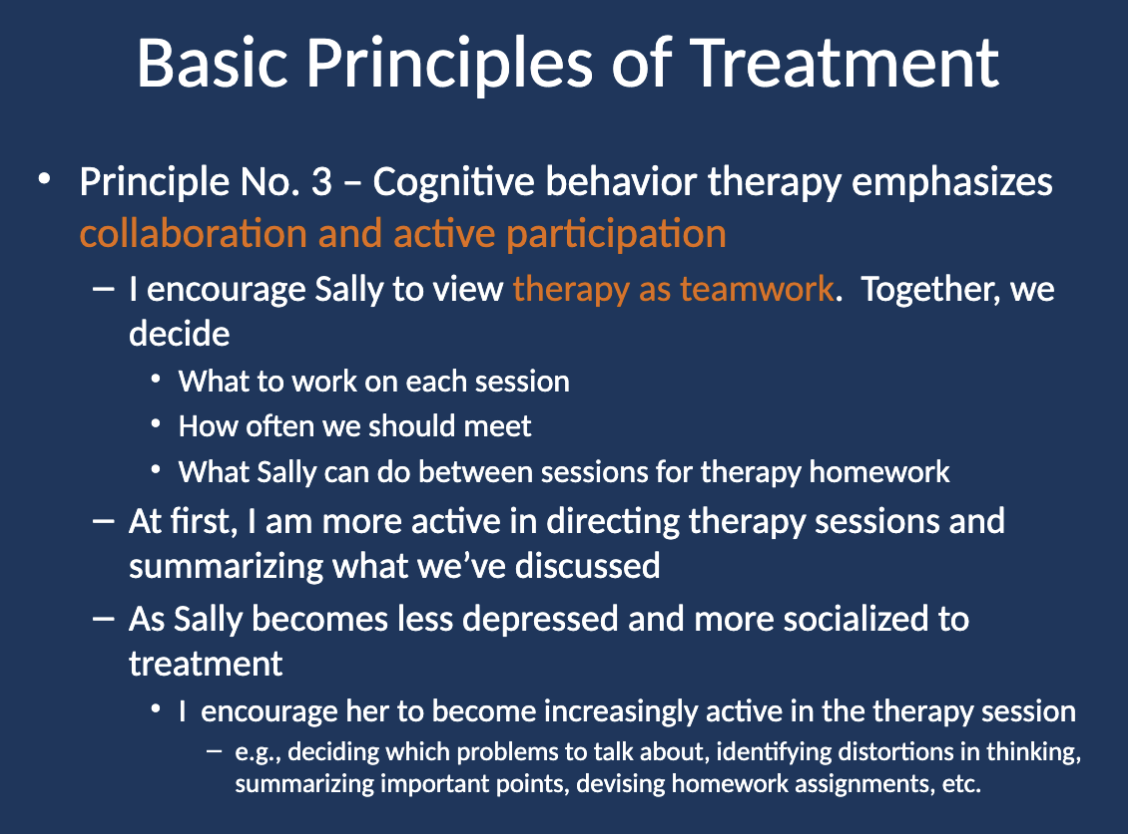
What is Principle No. 4 of CBT? (Basic Principles of Treatment: Principle 4)
CBT is goal oriented and problem focused.
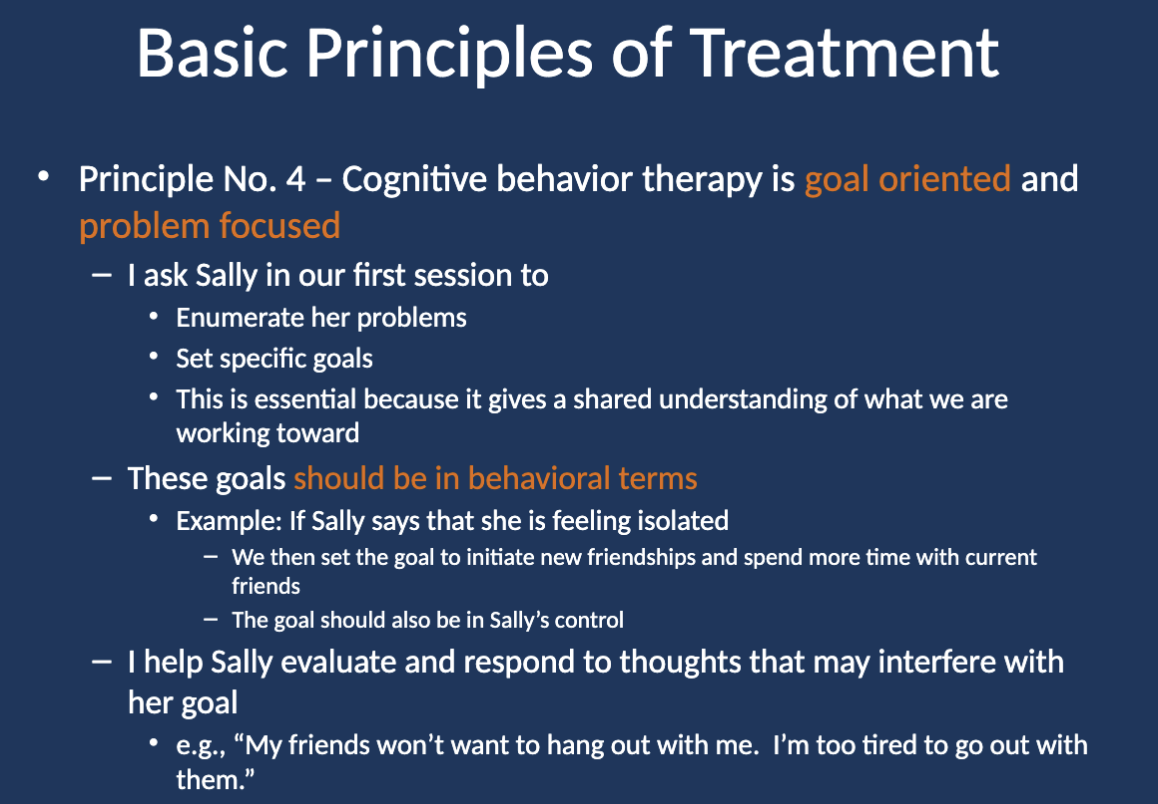
What do I ask Sally to do in our first session? (Basic Principles of Treatment: Principle 4)
I ask Sally to enumerate her problems and set specific goals.
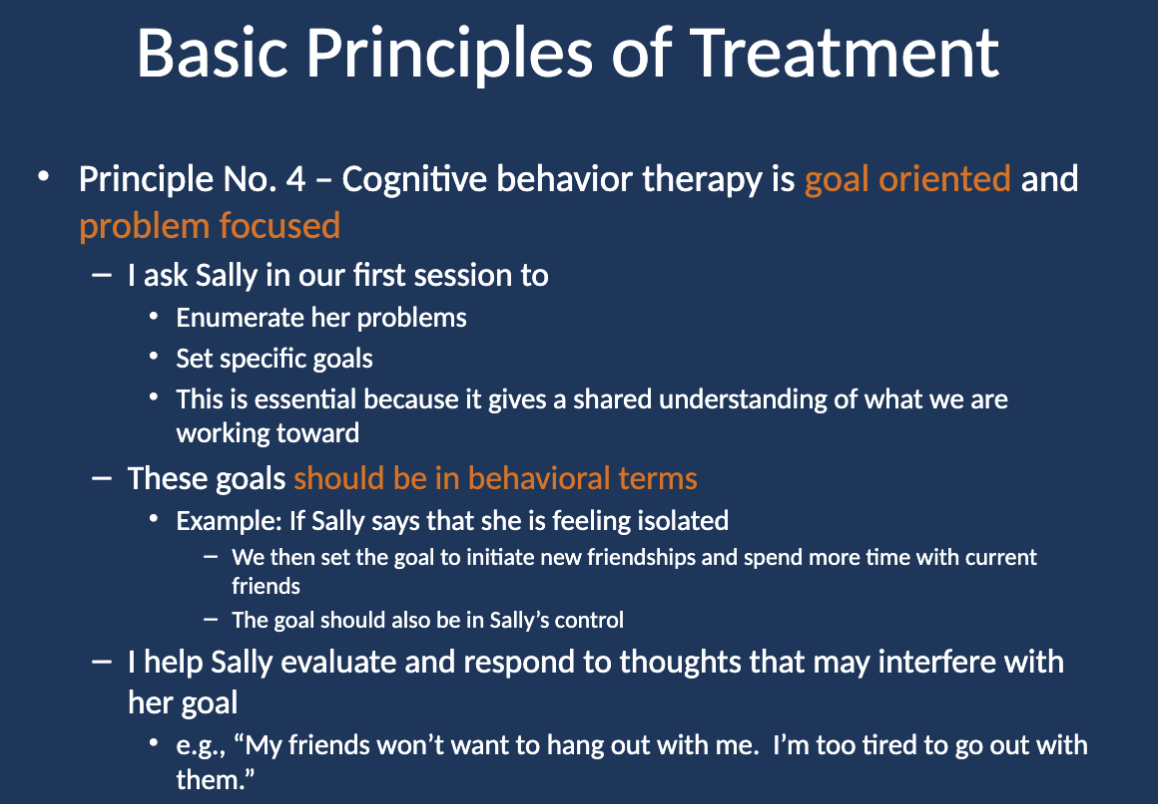
In what terms should these goals be set, and what’s an example? (Basic Principles of Treatment: Principle 4)
Goals should be in behavioral terms.
Example: If Sally feels isolated, we set a goal to initiate new friendships and spend more time with current friends.
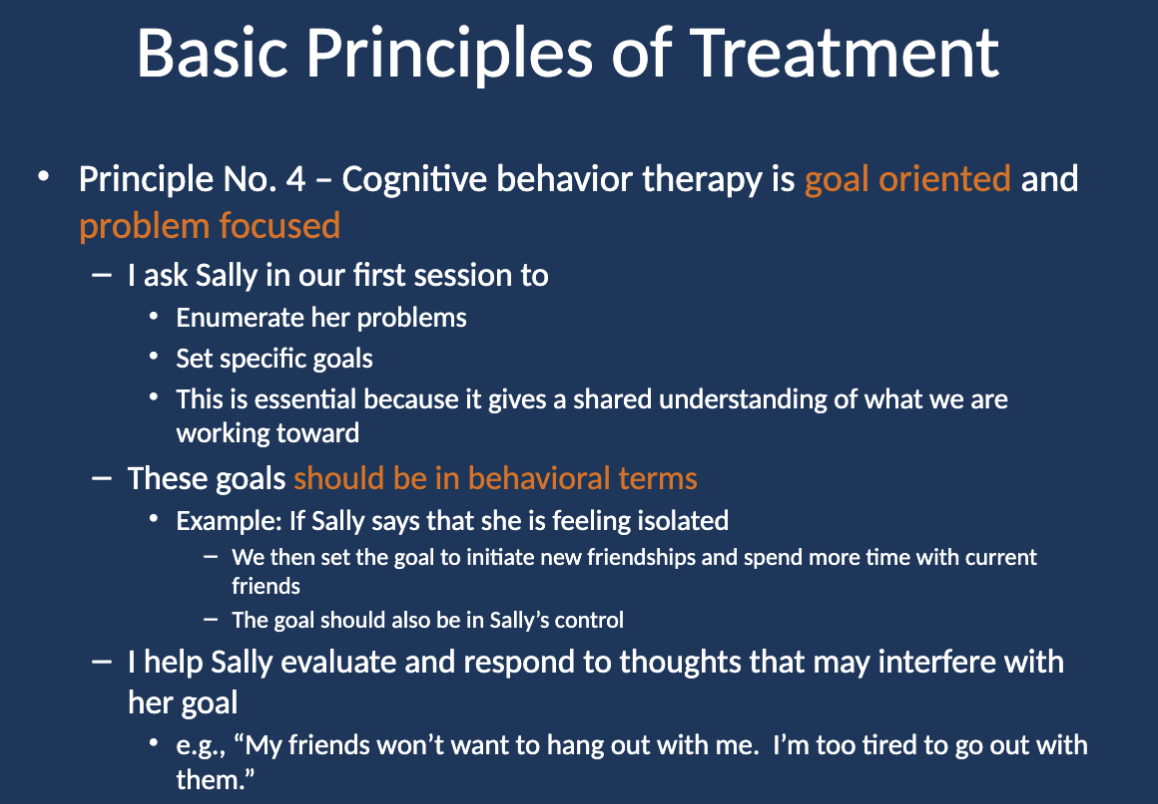
How do I help Sally evaluate and respond to interfering thoughts? (Basic Principles of Treatment: Principle 4)
I help her recognize and challenge thoughts that block her progress, such as “My friends won’t want to hang out with me” or “I’m too tired to go out.”

What is Principle No. 5 of CBT?(Basic Principles of Treatment: Principle 5)
CBT initially emphasizes the present.

What does treatment typically focus on? (Basic Principles of Treatment: Principle 5)
Treatment focuses on current problems and specific distressing situations.
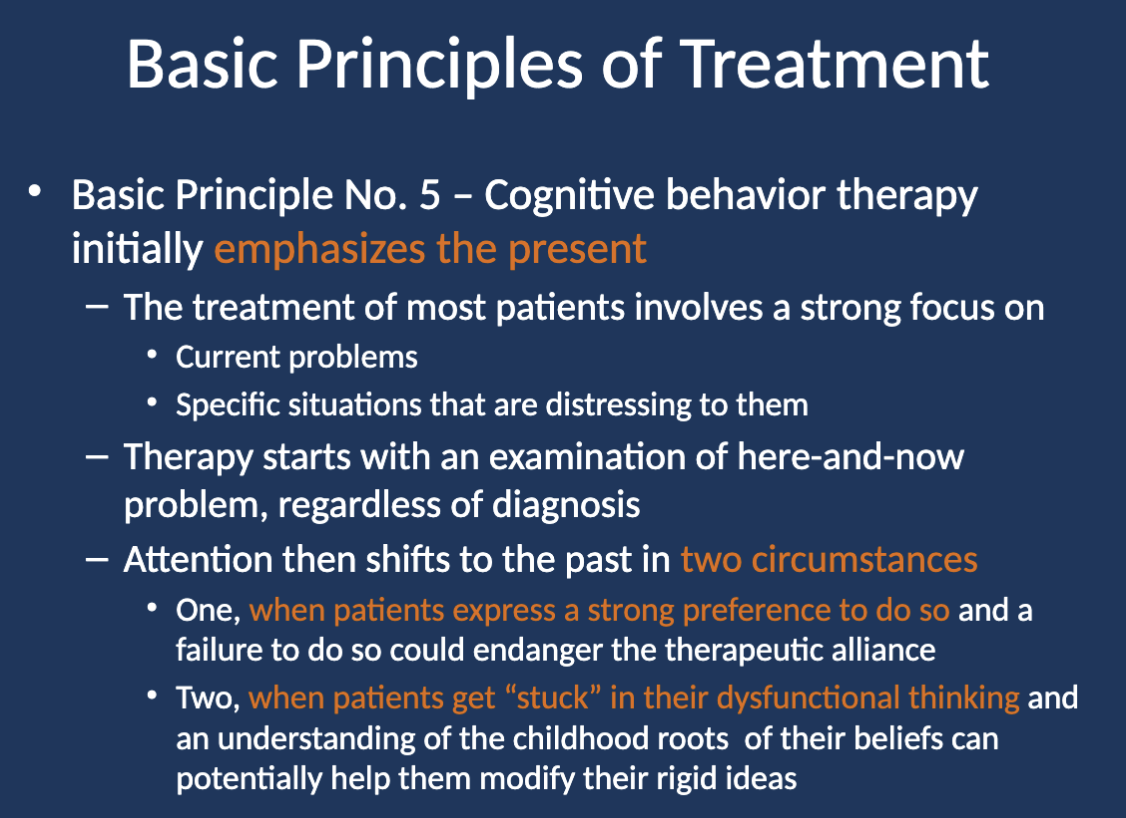
What does therapy start with? (Basic Principles of Treatment: Principle 5)
Therapy starts with an examination of the here-and-now problem, regardless of diagnosis.
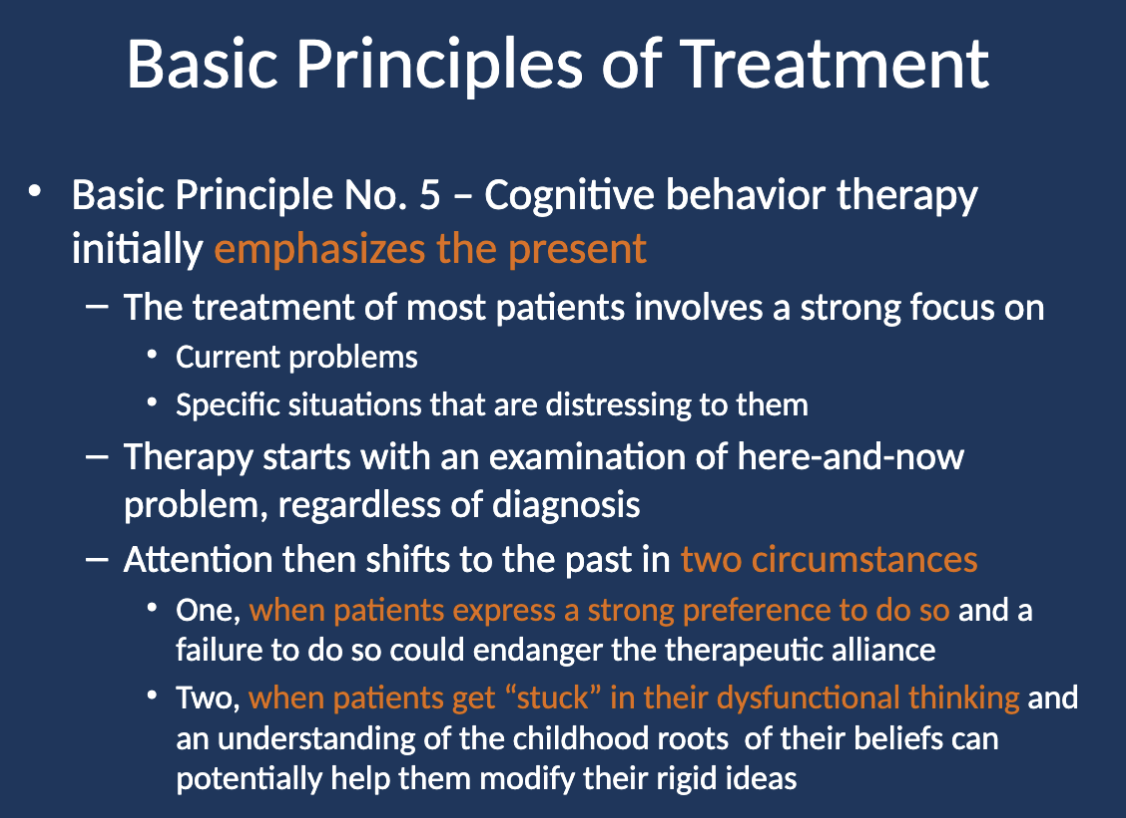
When does attention shift to the past? (Basic Principles of Treatment: Principle 5)
Attention shifts to the past in two circumstances:
When patients strongly prefer it and avoiding it could harm the therapeutic alliance.
When patients are stuck in dysfunctional thinking and understanding childhood roots could help.

What is the first circumstance that shifts attention to the past? (Basic Principles of Treatment: Principle 5)
When patients express a strong preference to discuss the past and avoiding it could damage the therapeutic alliance.
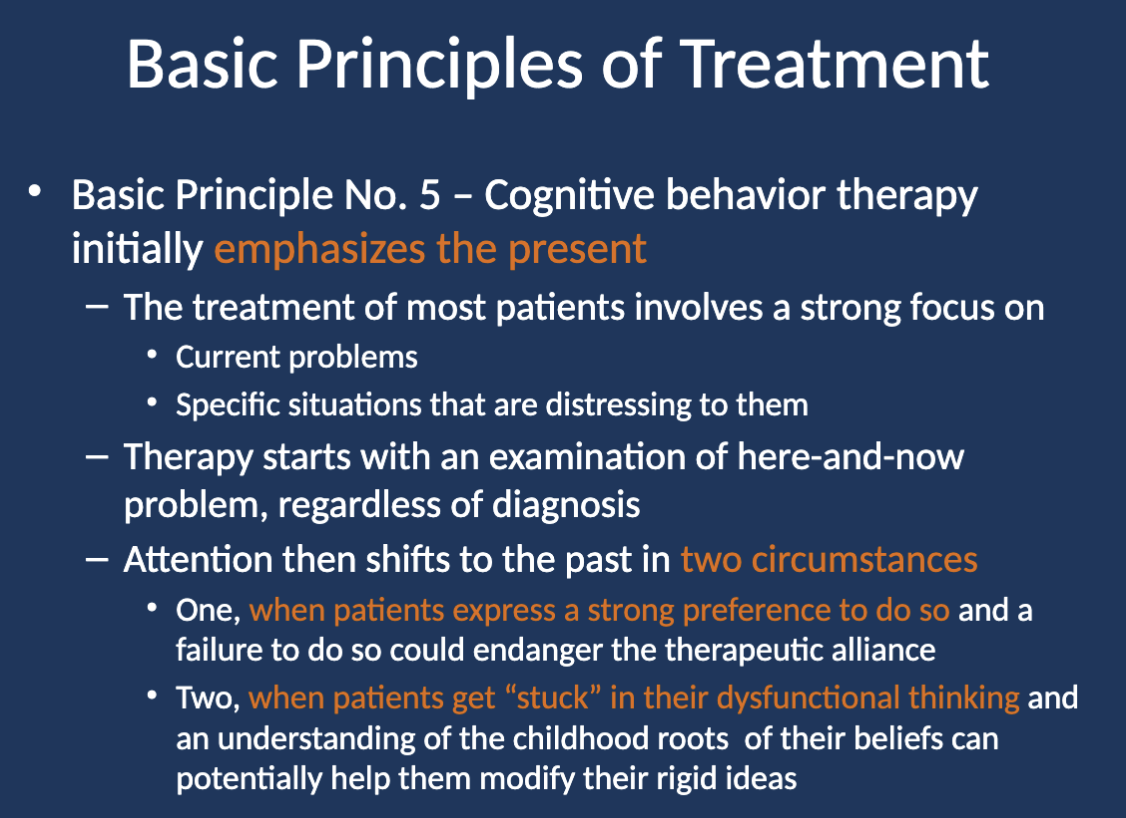
What is the second circumstance that shifts attention to the past? (Basic Principles of Treatment: Principle 5)
When patients are stuck in dysfunctional thinking and exploring childhood origins may help modify rigid beliefs.
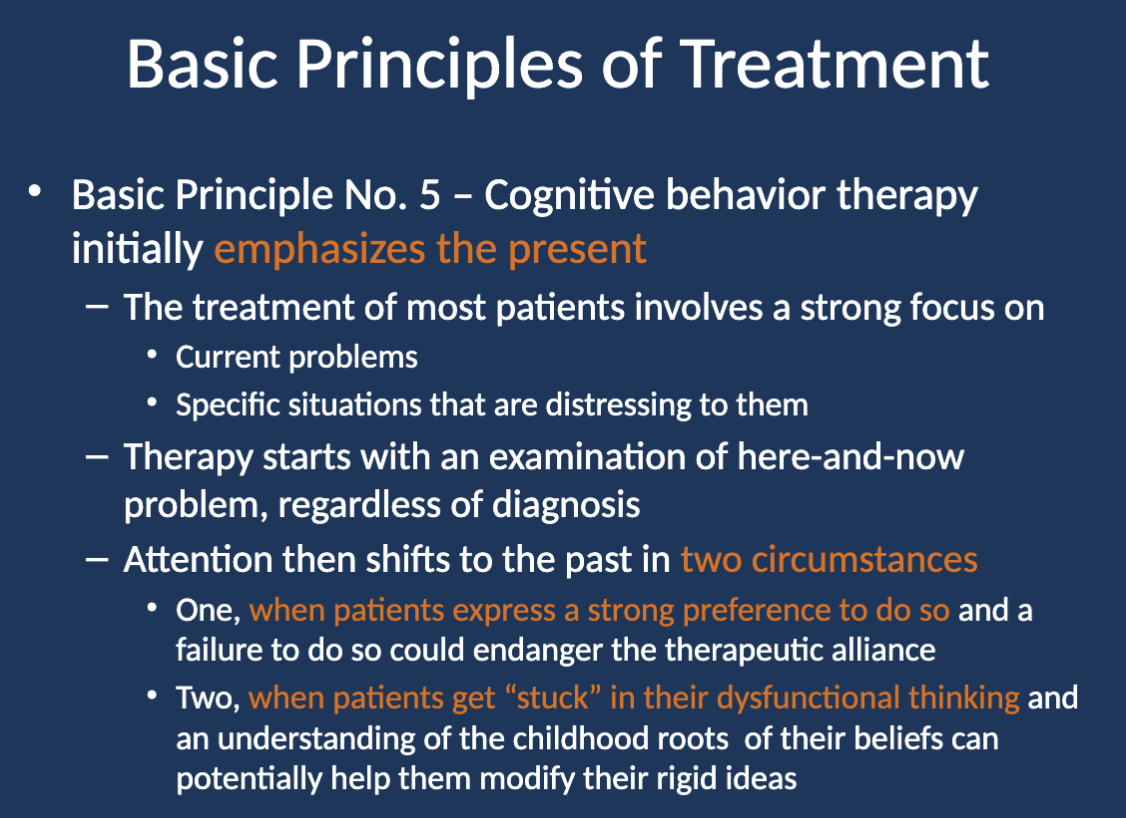
What is Principle No. 6 of CBT? (Basic Principles of Treatment: Principle 6)
CBT is educative, aims to teach the patient to be their own therapist, and emphasizes relapse prevention.
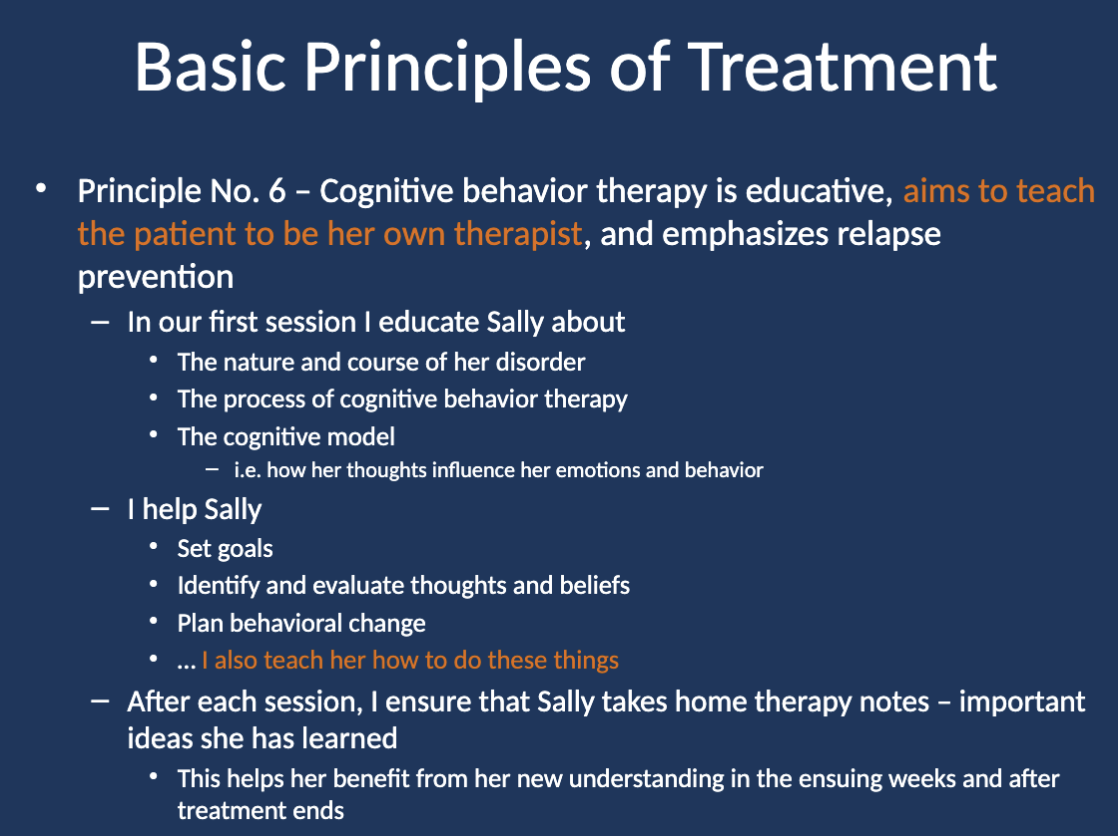
What do I do in the first session? (Basic Principles of Treatment: Principle 6)
I educate Sally about the nature and course of her disorder, the process of CBT, and the cognitive model (how thoughts influence emotions and behavior).

How do I help Sally during therapy? (Basic Principles of Treatment: Principle 6)
I help Sally set goals, identify and evaluate thoughts and beliefs, plan behavioral change, and teach her how to do these things herself.
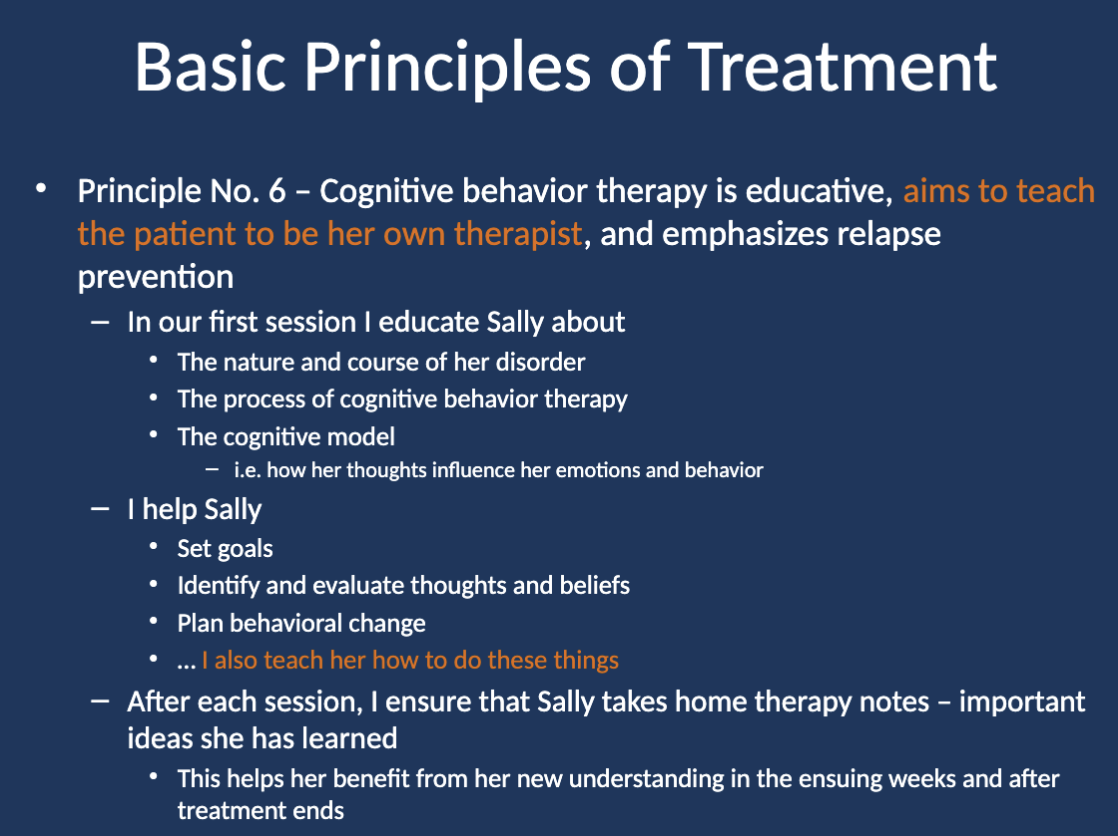
What do I do after each session? (Basic Principles of Treatment: Principle 6)
I ensure Sally takes home therapy notes containing important ideas she learned to help her apply the understanding between and after sessions.
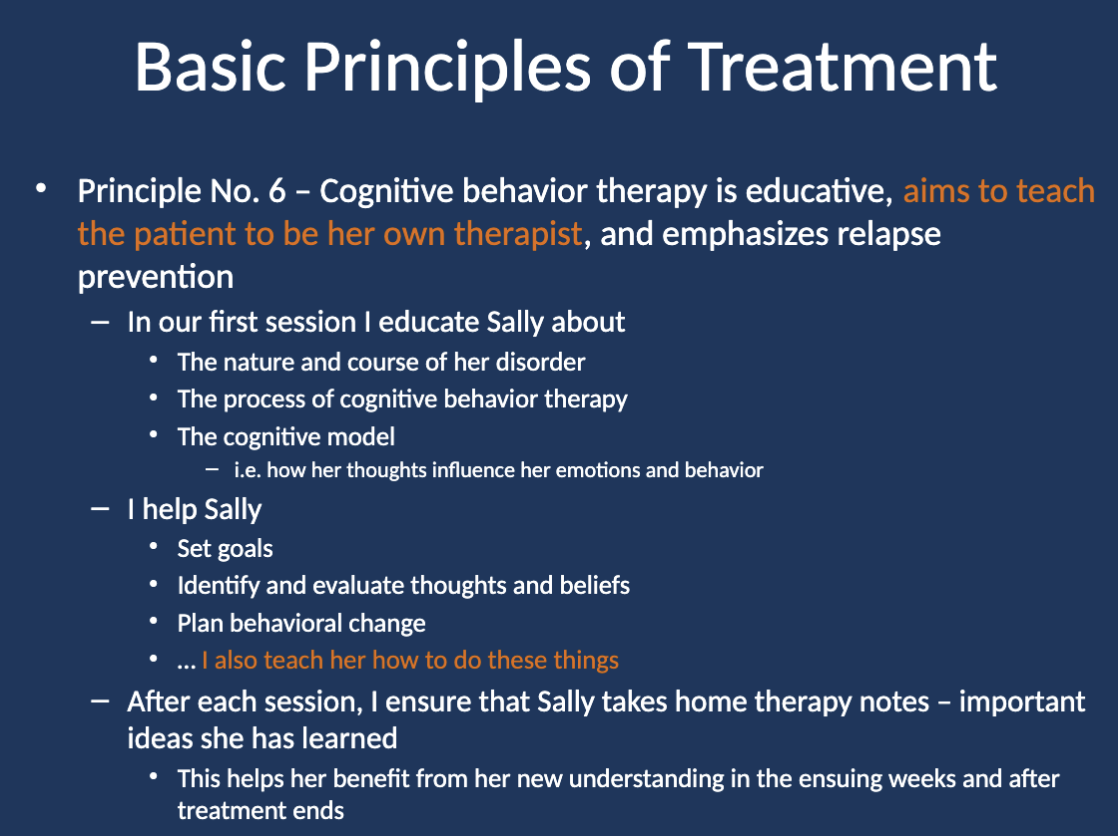
What is Principle No. 7 of CBT? (Basic Principles of Treatment: Principle 7)
CBT aims to be time-limited.
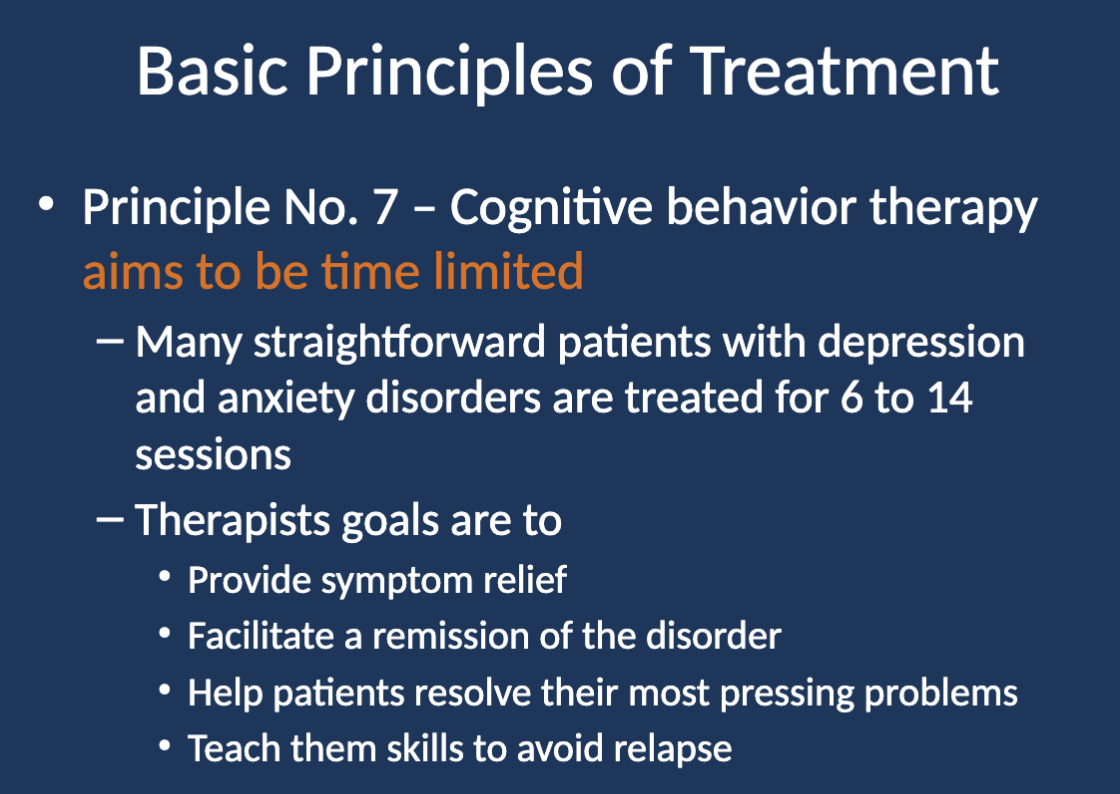
How many sessions are typically needed for CBT treatment? (Basic Principles of Treatment: Principle 7)
Many straightforward patients with depression and anxiety disorders are treated for 6 to 14 sessions.

What are the therapist’s goals in CBT? (Basic Principles of Treatment: Principle 7)
The therapist's goals are to provide symptom relief, facilitate remission of the disorder, help patients resolve their most pressing problems, and teach skills to avoid relapse.
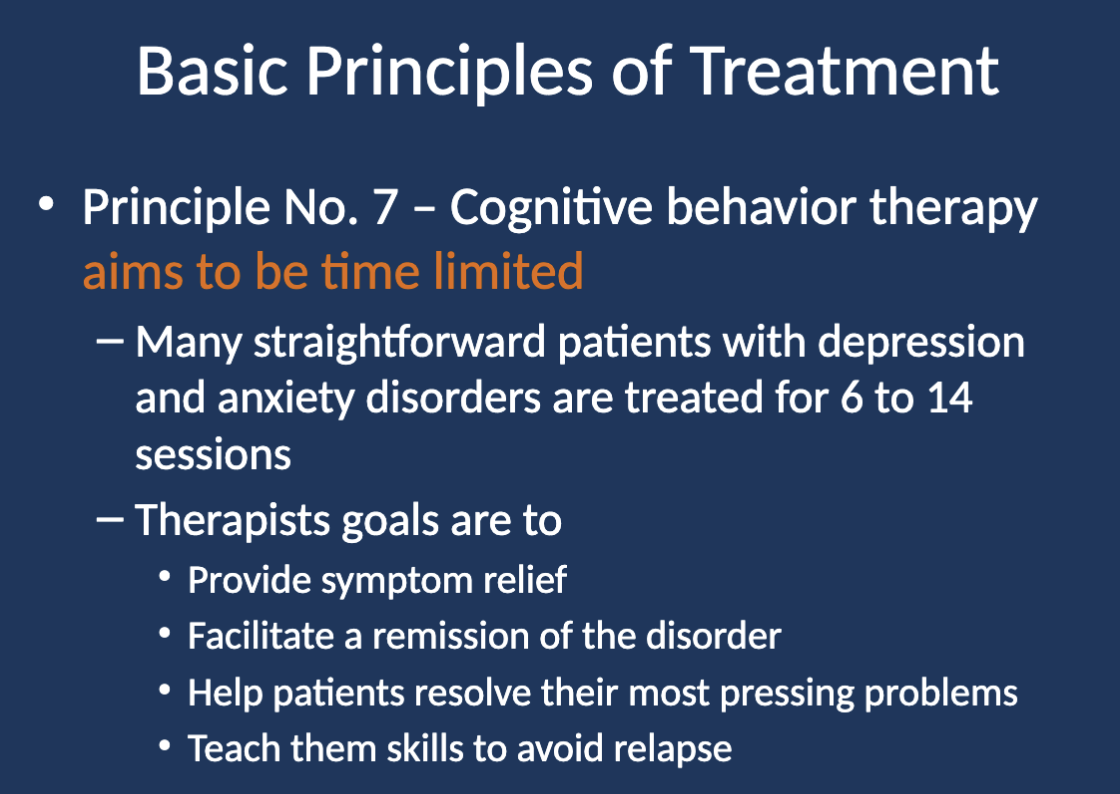
What is Principle No. 8 of CBT? (Basic Principles of Treatment: Principle 8)
CBT sessions are structured.
What are the three parts of structure in CBT sessions? (Basic Principles of Treatment: Principle 8)
Introductory part
Middle part
Final part
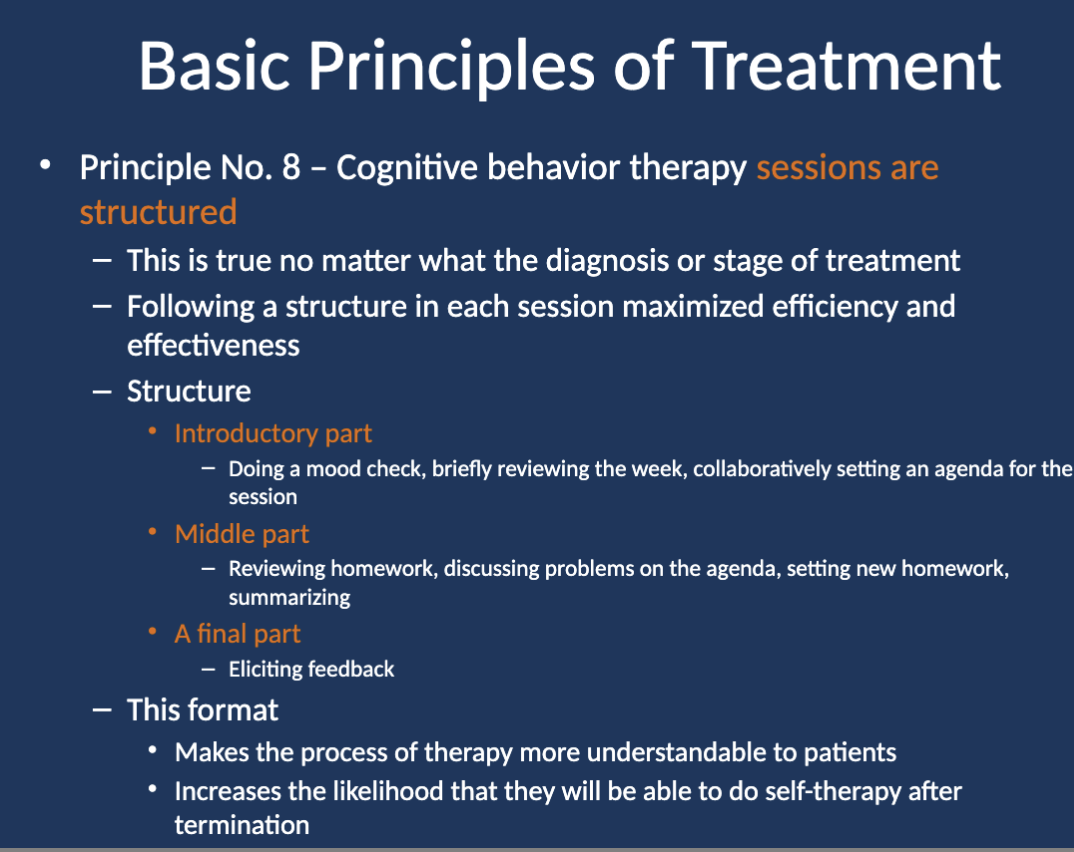
What is included in the introductory part of a CBT session? (Basic Principles of Treatment: Principle 8)
The introductory part includes a mood check, briefly reviewing the week, and collaboratively setting an agenda for the session.
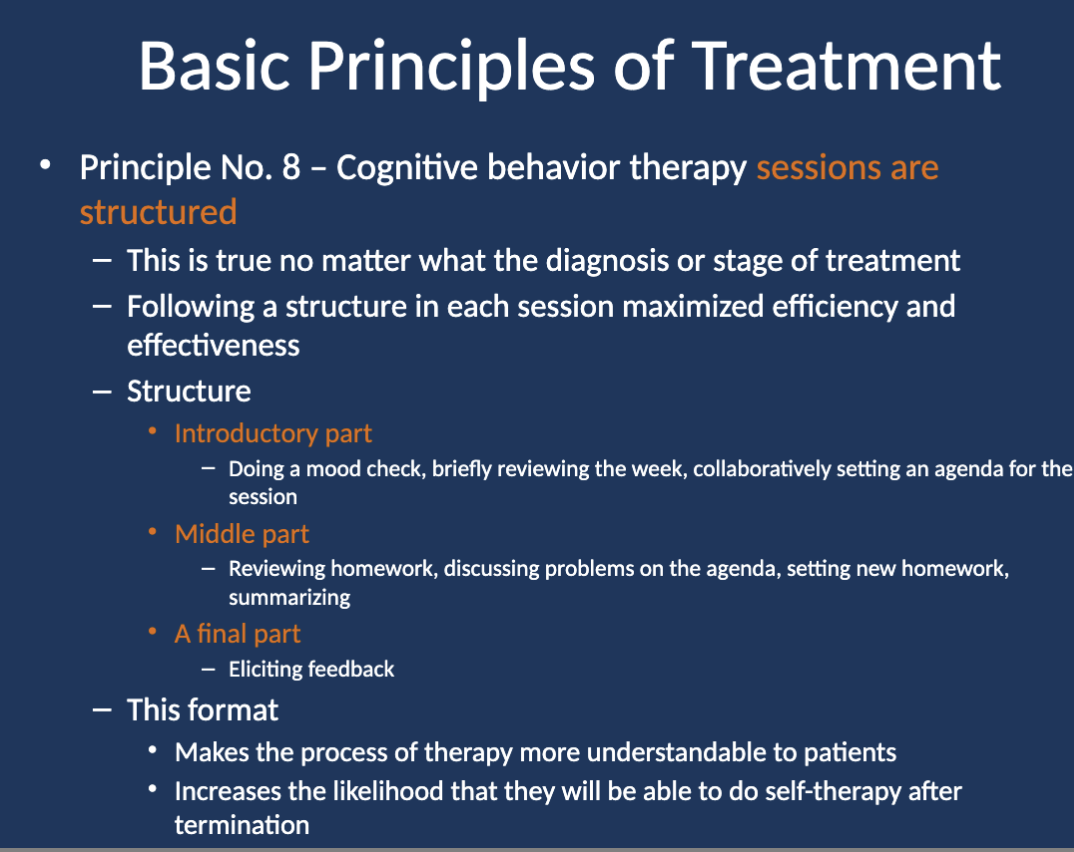
What happens in the middle part of a CBT session? (Basic Principles of Treatment: Principle 8)
The middle part involves reviewing homework, discussing problems on the agenda, setting new homework, and summarizing the session.
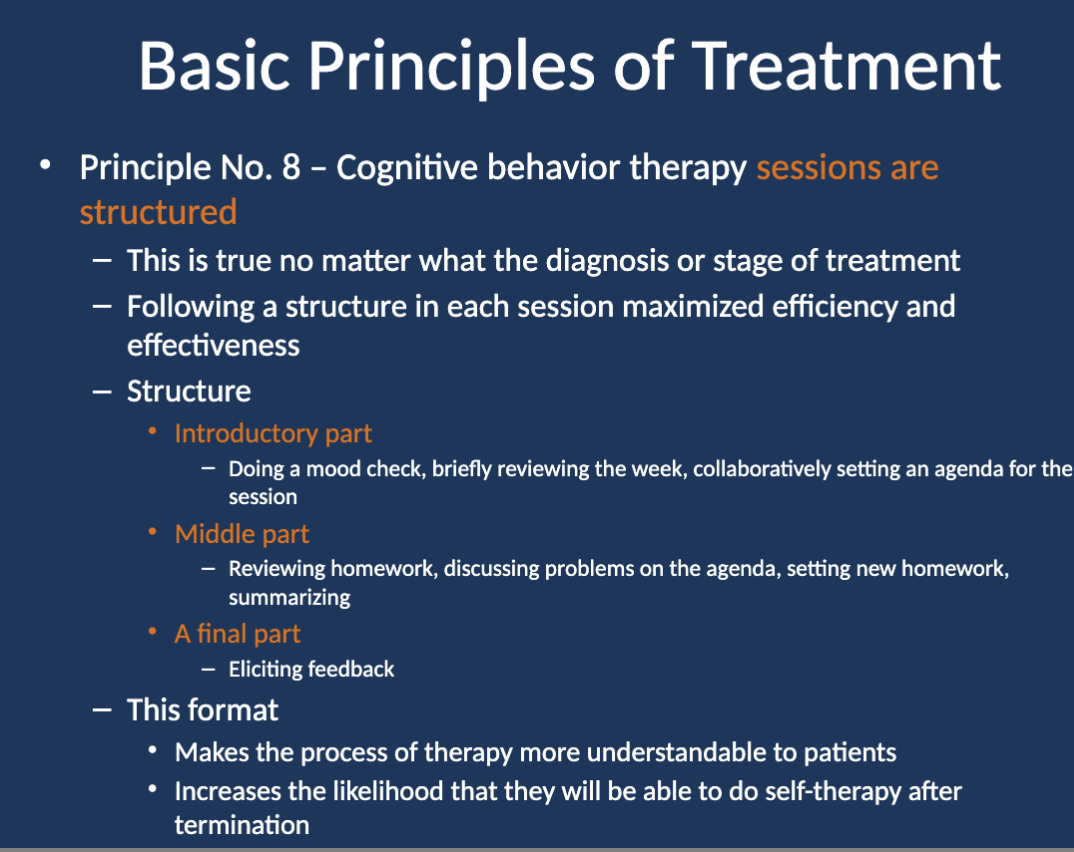
What happens in the final part of a CBT session? (Basic Principles of Treatment: Principle 8)
The final part involves eliciting feedback from the patient.
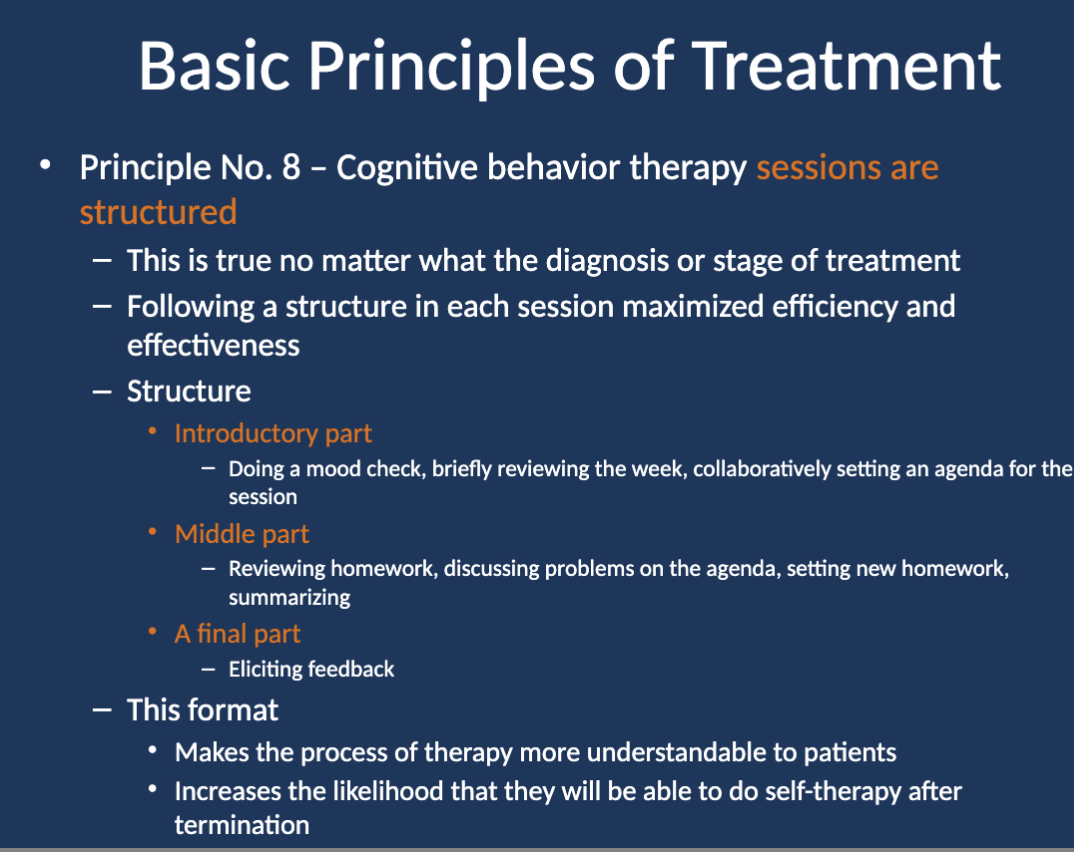
What does the structured format of CBT do for patients? (Basic Principles of Treatment: Principle 8)
It makes the process of therapy more understandable and increases the likelihood that patients will be able to do self-therapy after termination.
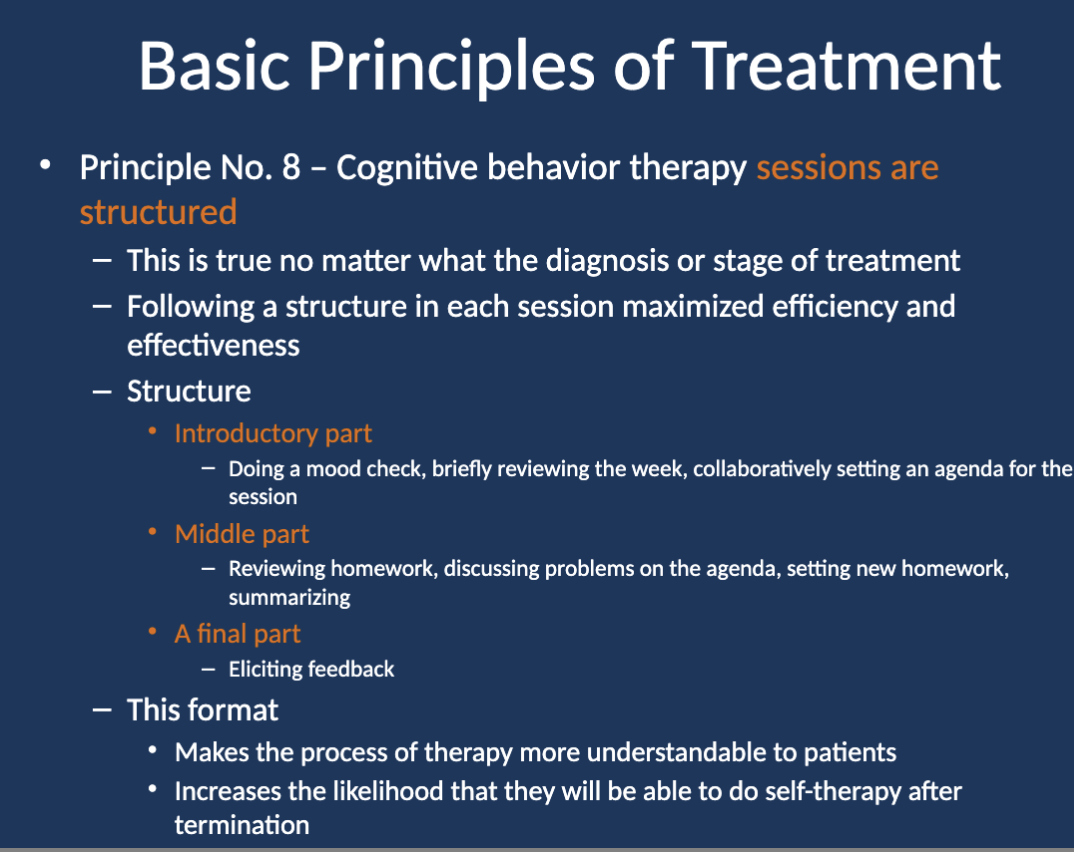
What is Principle No. 9 of CBT? (Basic Principles of Treatment: Principle 9)
CBT teaches patients to identify, evaluate, and respond to their dysfunctional thoughts and beliefs.
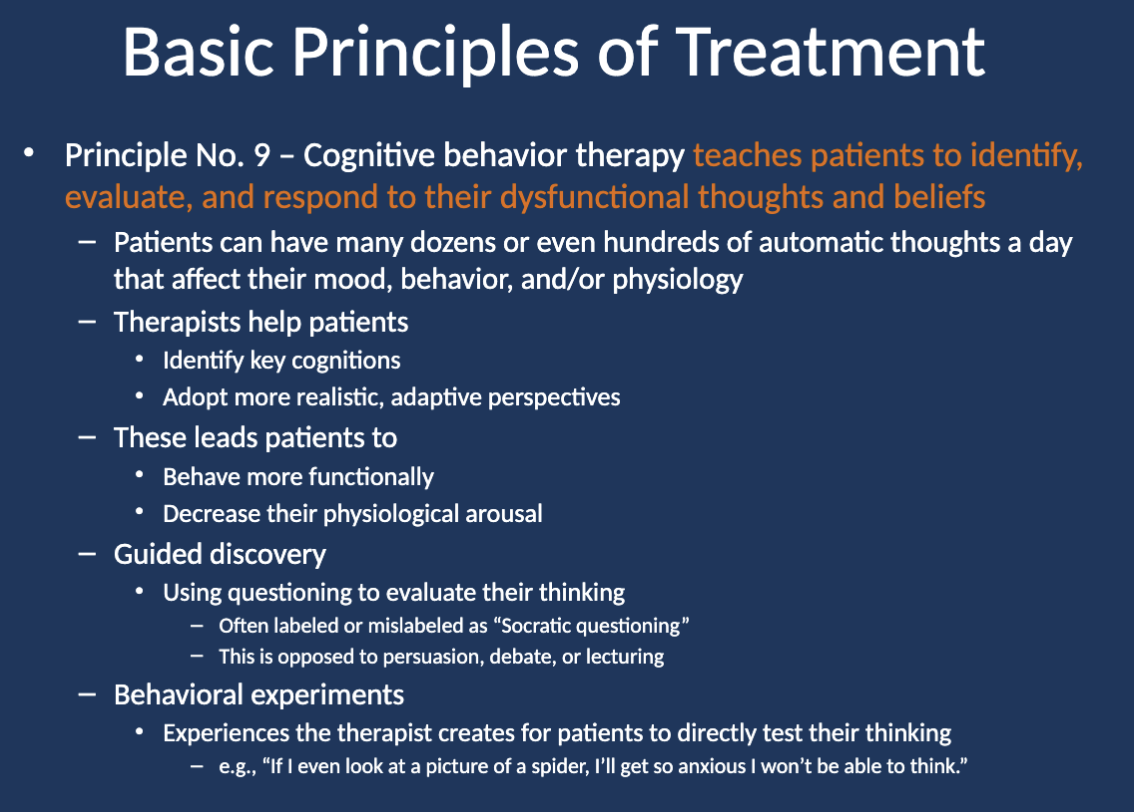
How do therapists help patients in CBT? (Basic Principles of Treatment: Principle 9)
Therapists help patients identify key cognitions and adopt more realistic, adaptive perspectives.
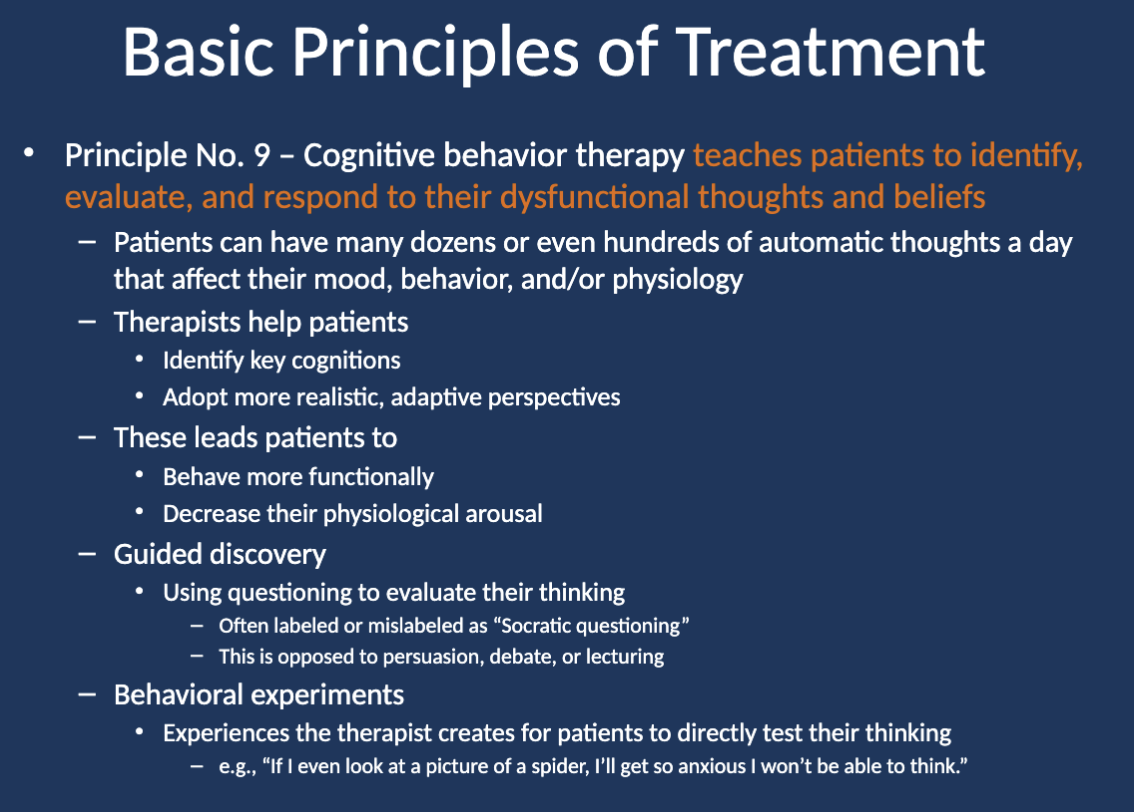
What does this help patients do in CBT? (Basic Principles of Treatment: Principle 9)
It leads patients to behave more functionally and decrease their physiological arousal.
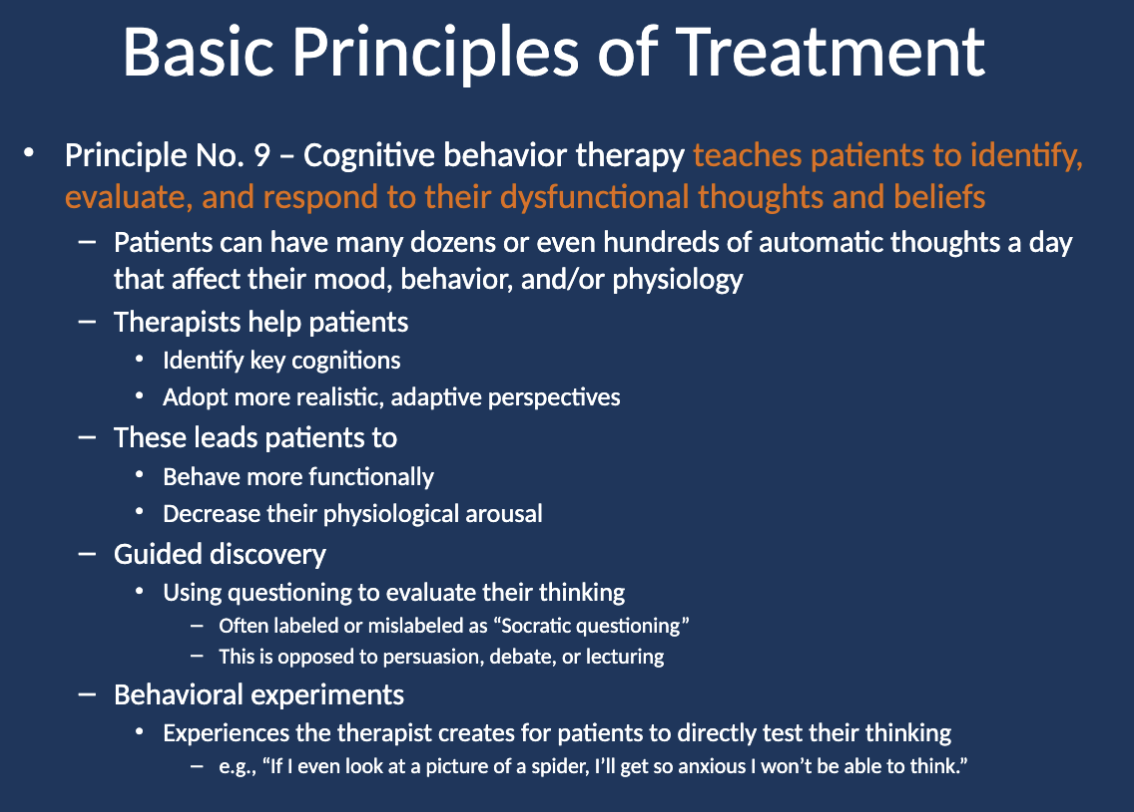
What is guided discovery in CBT? (Basic Principles of Treatment: Principle 9)
Guided discovery is using questioning to evaluate a patient's thinking, often labeled as "Socratic questioning," opposed to persuasion, debate, or lecturing.
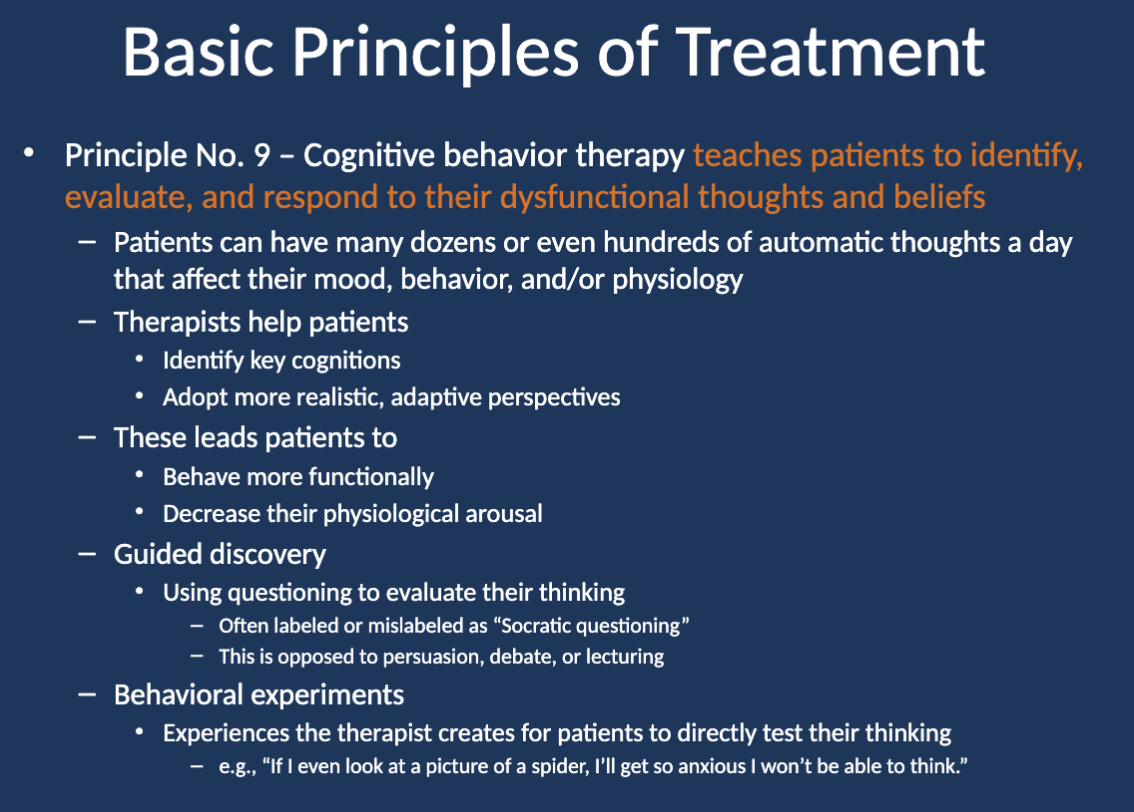
What are behavioral experiments in CBT? (Basic Principles of Treatment: Principle 9)
Behavioral experiments are experiences the therapist creates for patients to directly test their thinking. For example, testing the thought, "If I even look at a picture of a spider, I’ll get so anxious I won’t be able to think."

What is Principle No. 10 of CBT? (Basic Principles of Treatment: Principle 10)
CBT uses a variety of techniques to change thinking, mood, and behavior.

What are some essential techniques used in CBT? (Basic Principles of Treatment: Principle 10)
Socratic questioning and behavioral experiments are essential. Additionally, techniques from other orientations, like Gestalt and psychodynamic, can be implemented within a cognitive framework.

How might Gestalt-inspired techniques be helpful in CBT? (Basic Principles of Treatment: Principle 10)
Gestalt-inspired techniques might help a patient understand how familiar experiences have shaped their beliefs.
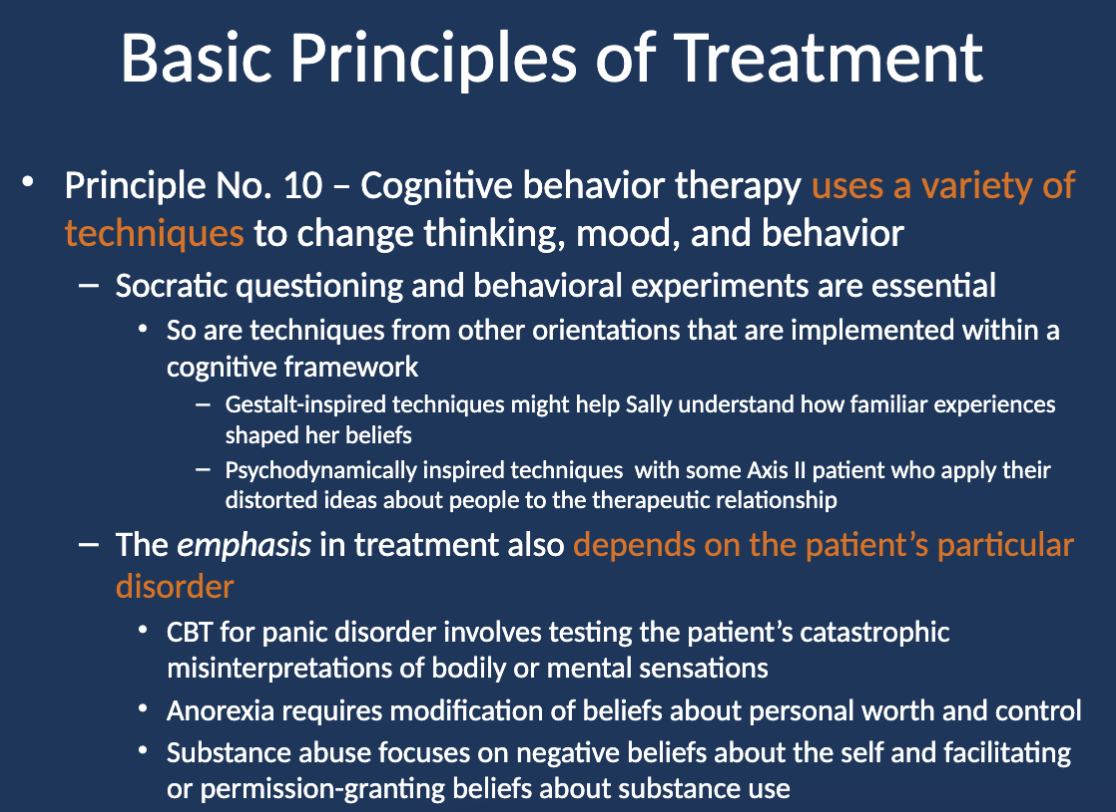
How might psychodynamically inspired techniques be helpful in CBT? (Basic Principles of Treatment: Principle 10)
Psychodynamically inspired techniques can be helpful for Axis II patients who apply distorted ideas about people to the therapeutic relationship.
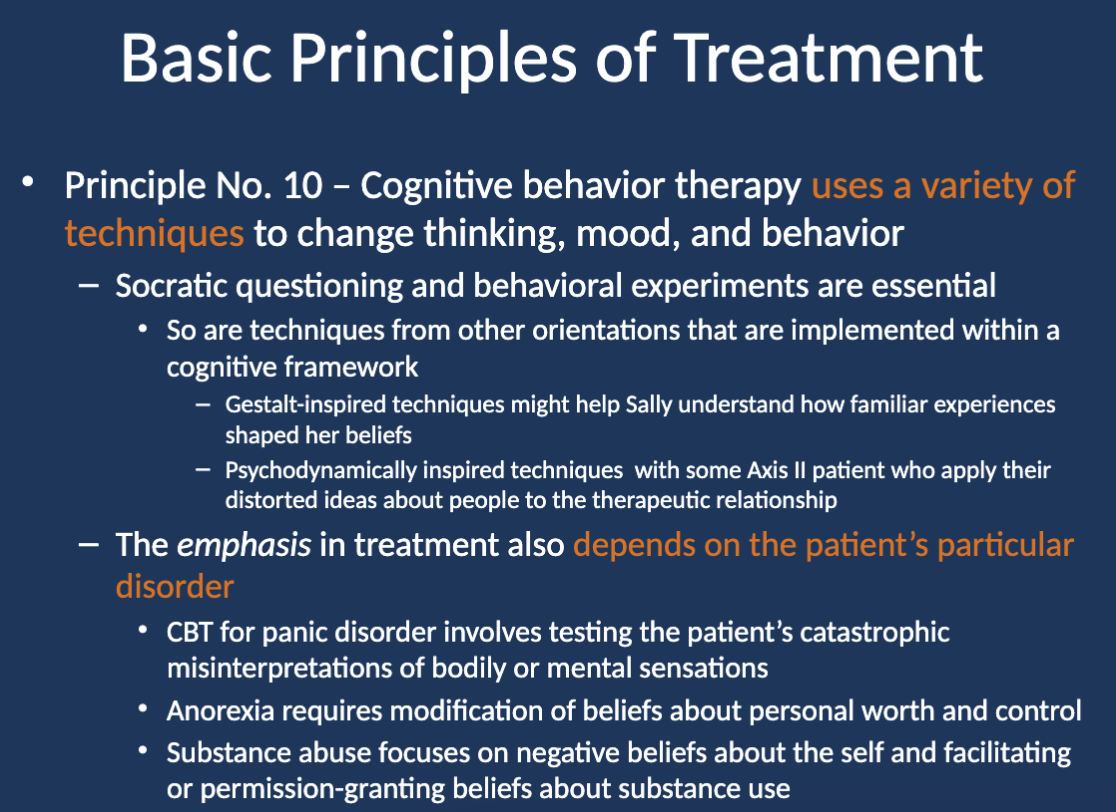
What does the emphasis in treatment depend on in CBT? (Basic Principles of Treatment: Principle 10)
The emphasis in treatment depends on the patient’s particular disorder.
Panic disorder: Focuses on testing the patient’s catastrophic misinterpretations of bodily or mental sensations.
Anorexia: Focuses on modifying beliefs about personal worth and control.
Substance abuse: Focuses on negative beliefs about the self and facilitating permission-granting beliefs about substance use.
